NMR Analysis of Vinegar for Authentification and Detection of Adulteration
Over the past few years balsamic vinegars have been the subject of a number or NMR studies to determine authenticity, degree of aduleration, and age. 1H NMR has been used to quantify the relative concentrations of a series of organic components (ethanol, fructose, glucose, acetic acid, succinic acid, lactic acid, butandiol, etc (ref 1). 13C NMR has been used to determine the aunthenticity and degree of adulteration (ref 2) as well as the length of the ageing process that a given sample has undergone. Also the formation of glucose and fructose acetates during maturation and ageing has been studied by 1H and 13C NMR.
Refs.
1) Caligiani et al., Anal. Chim. Acta, 585 (2007) 110-119
2) Consonni et al., Talanta, 75 (2008) 765-769
3) Consonni et al., Anal. Chim. Acta, 611 (2008) 31-40
4) Consonni and Caligiani, Talanta, 73 (2007) 332-339
5) Cirlini et al, Food Chemistry, 112 (2009) 51-56
The concentration and distribution of the organic components has been found to correlate well with ageing process analysis, identification of adulteration, and determination of authenticity of traditional balsamic vinegars and balsamic vinegars of Modena.
Below are a series of spectra showing what can chemistry can be quantified in the balsamic vinegars as well as a few comparative spectra of apple cider vinegar and malt vinegar.








NMR Analysis of Commercial Pear Cider
For comparison with the home made ciders analyzed in the previous posting I am including the NMR of analysis of a commercial pear cider. The previous ciders were very dry while the pear cider was decidedly sweet. The carbohydrate content is a notable difference. The 1H spectrum is shown with chemical components identified.

1H NMR Analysis of Hard Apple Cider
There have been quite a lot of NMR studies centered around apple cider (non-alcoholic) and apple cider vinegar. However a search of the literature turns up no reference for NMR analysis of hard apple cider. This effort was undertaken to analyse the alcohol content of the ciders and to determine the malic and acetic acid content. Ciders were produced by Dr Tim McMahon of Orange Community College, NY….for his own consumption.
Below are the NMR spectra obtained by regular 1H acquisition and with BINOM solvent suppression.
Data was obtained on our Varian 300 MHz spectrometer. Samples were prepared by degassing followed by addition of 1 drop of D2O as lock solvent.
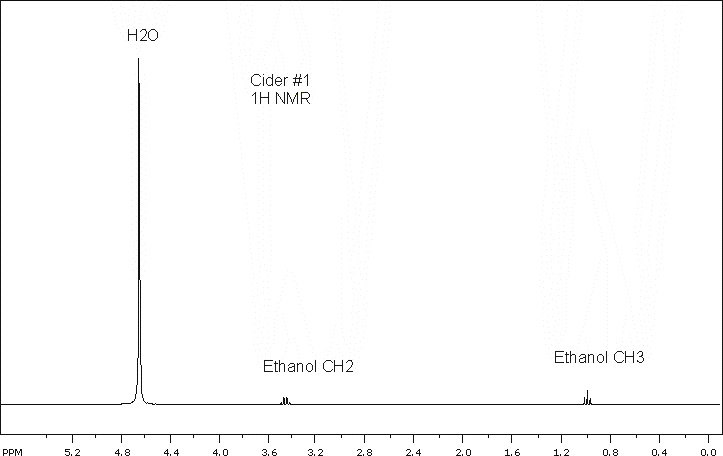
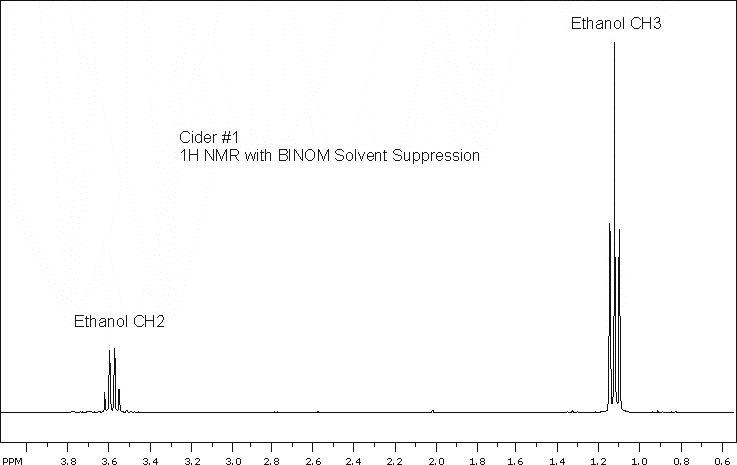
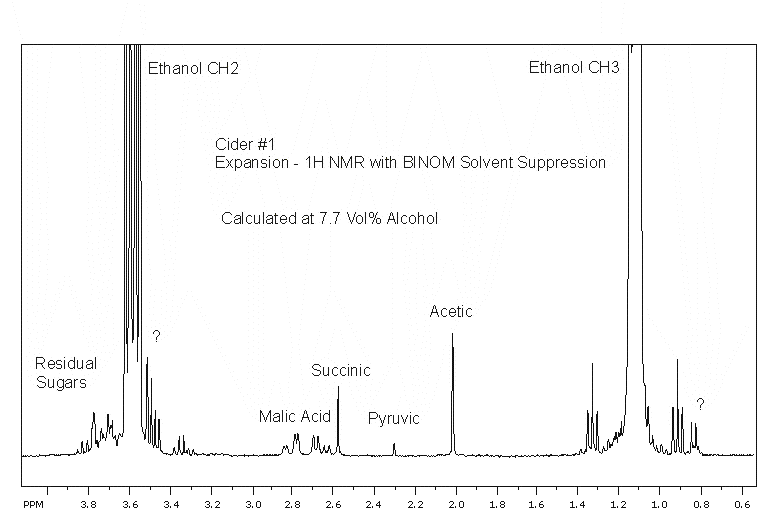
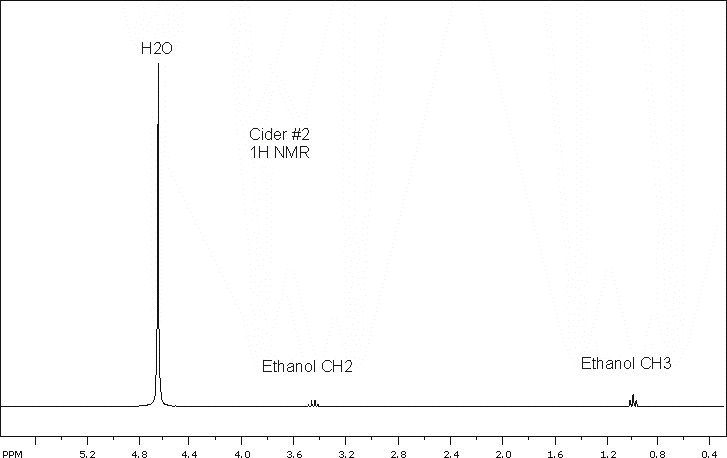
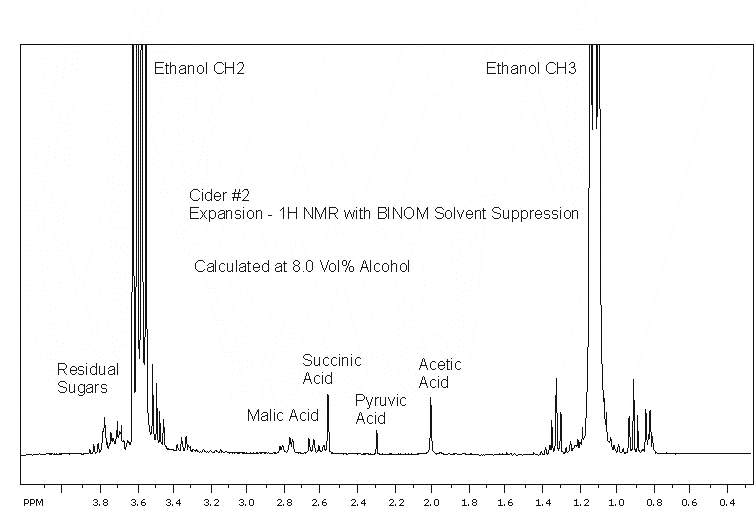
Micro-ESR Spectrometry of Crude Oils
Process NMR Associates, LLC (Danbury CT) and Active Spectrum, Inc (San Carlos CA) are collaborating in the application of micro-ESR technology to petroleum applications. The initial work has focussed on crude oils but will soon be expanded to residues and cracker feedstocks.
Five samples of crude oil were tested by Micro-ESR spectrometry. The samples were:
1. Vasconia, Magdalena Basin, Columbia (V=39 ppm)
2. Merey, Eastern Venezuela Basin, Venezuela (V=303 ppm)
3. Oriente, Oriente Basin, Ecuador (V=65 ppm)
4. Qua Iboe, Agbada Formation, Niger Delta (V=2 ppm)
5. Basrah Light, Zubair Zone, Iraq (V=29 ppm)
The following spectra were observed:
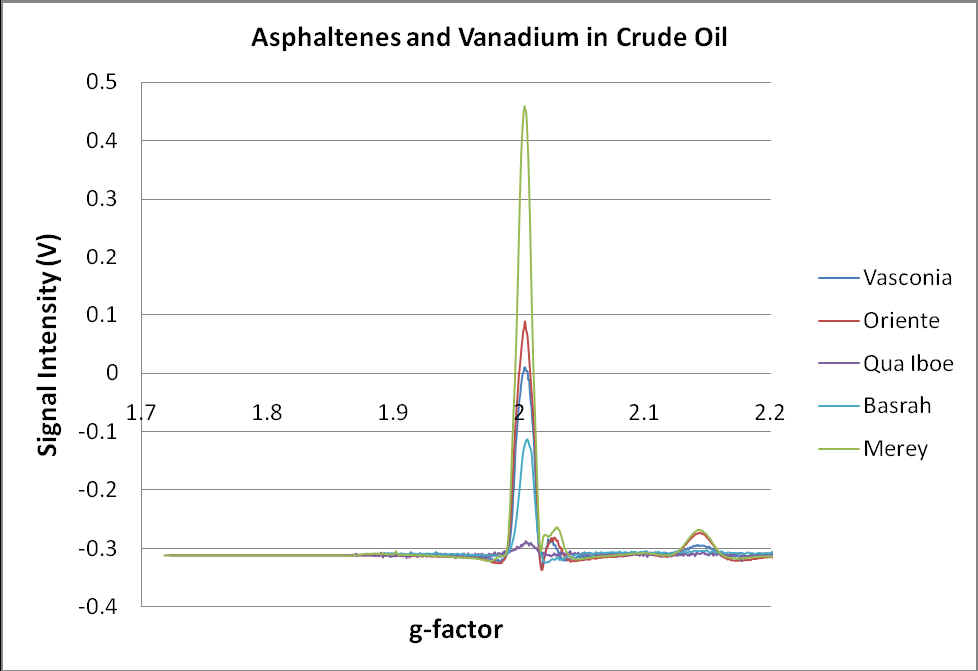
Figure 1: Micro-ESR Spectra of Crude Oil
The central peak is a combination of a persistent carbon-centered organic radical (g = 2.003) found in asphaltenes, and a vanadyl (VO2+) peak. The additional smaller peaks are associated with vanadyl only.
For producers, the technique could be used to rapidly measure asphaltene concentration on-line. The spin density of the organic radical is a function of the maturity of the oil and will of course vary between deposits. Notwithstanding, rapid electronic measurement of asphaltenes remains a topic of great interest. Similar techniques have also been used to assess the quality of coals. For refiners, vanadium is a contaminant that poisons the refinery catalyst. ESR has been used by refiners since 1962 to rapidly measure vanadium content in crude oil feedstocks both on-line and in laboratories. Active Spectrum Inc.’s Micro-ESR is shown below. It is 2.25″ in diameter by 2.5″ high. Power input is 12-30VDC, and the data interface is USB. The device is available as either an on-line sensor or as a benchtop unit.
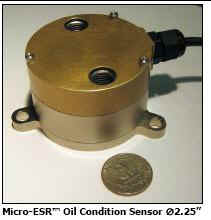
Figure 2: Micro-ESR Sensor
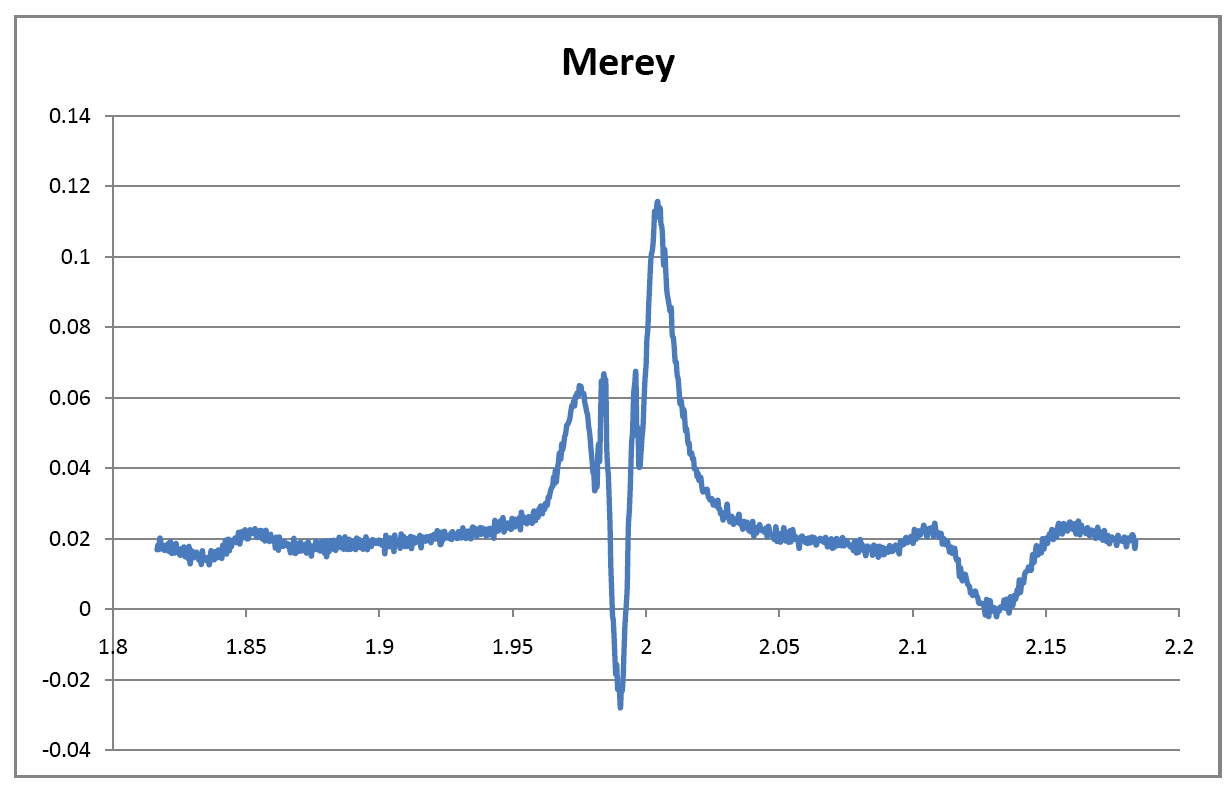
Figure 3: Higher Homogeneity Spectrum of Merey Crude
Micro-ESR is complimentary to NMR in that it observes paramagnetic metals and organic radicals which are unobservable by NMR. The stable free radical signal is indicative and quantitative to the amount of asphaltenes in the crude oil sample and vanadium metal content is an important processing parameter for cracking processes as it is active in the passivation of catalysts. NMR on the other hand observed the detailed hydrocarbon chemistry of the sample and yields chemico-physical parameters such as aromaticity, paraffinicity, naphthenicity, distillation, density, PAH distribution. In combination these two technologies yield a detailed picture of the petroleum materials before and during the refining process.
Samples provided by John Edwards of Process NMR Associates, LLC. Micro-ESR analysis provided by James White of Active Spectrum, Inc,

Active Spectrum, Inc. 110 Glenn Way #15, San Carlos, CA 94070 650-610-0720 | 626-628-1970 f |activespectrum.com

Process NMR Associates, LLC. 87A Sand Pit Rd, Danbury, CT 06810 203-744-5905 | 203-743-9297 f |process-nmr.com
PDF Version of Application Note
For more information contact John Edwards (203) 744-5905
Residual Catalytic Cracking (RCC) – Feedstream Analysis by NMR
Current Technique for Feedstream Analysis:
Analysis Performed – Refractive Index, Distillation, Specific Gravity
Calculation Obtained – Watson K-Factor
Outcome: aromatic carbon number, aromatic hydrogen number, total hydrogen content
Proposition: Detailed hydrocarbon analysis for kinetic model development.
Our experience is that an improved and useful analysis can be obtained from NMR
analysis. There are several ways to approach the NMR analysis and the
chemometric approach to correlating NMR data to physico-chemical parameters of
use to process control.
RCC Feedstream Analysis by 1H and 13C NMR: Multivariate Prediction of Chemical and Physical Properties
Presented at the 236th ACS National Meeting, Philadelphia PA, August 17-21, 2008
John C. Edwards Ph.D.
Process NMR Associates LLC
87A Sand Pit Rd, Danbury, CT 06810
Jincheol Kim,
SK Energy Co., Ltd, SK Energy Technology Center,
140-1, Wonchon-dong, Yuseong-gu, Daejeon 305-712, Korea
Summary of Slides
1) 60 MHz process NMR data available from online NMR unit.
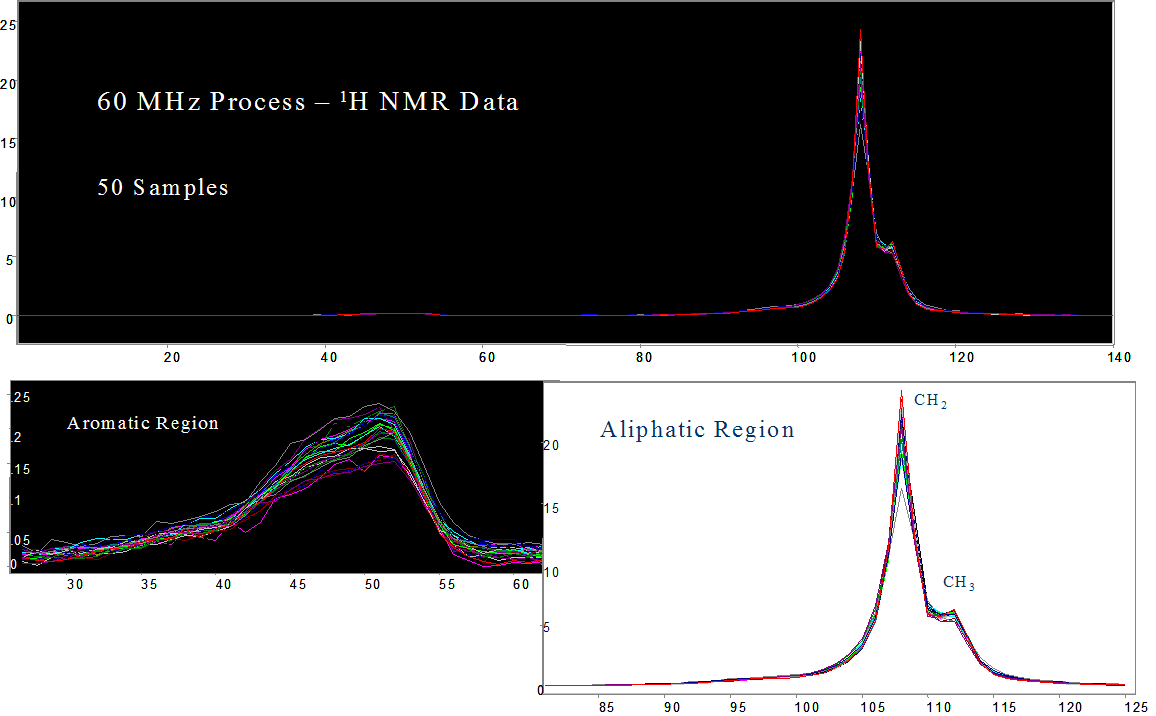
2) 300 MHz 1H NMR data available from standard NMR experiments on laboratory NMR system at Process NMR Associates
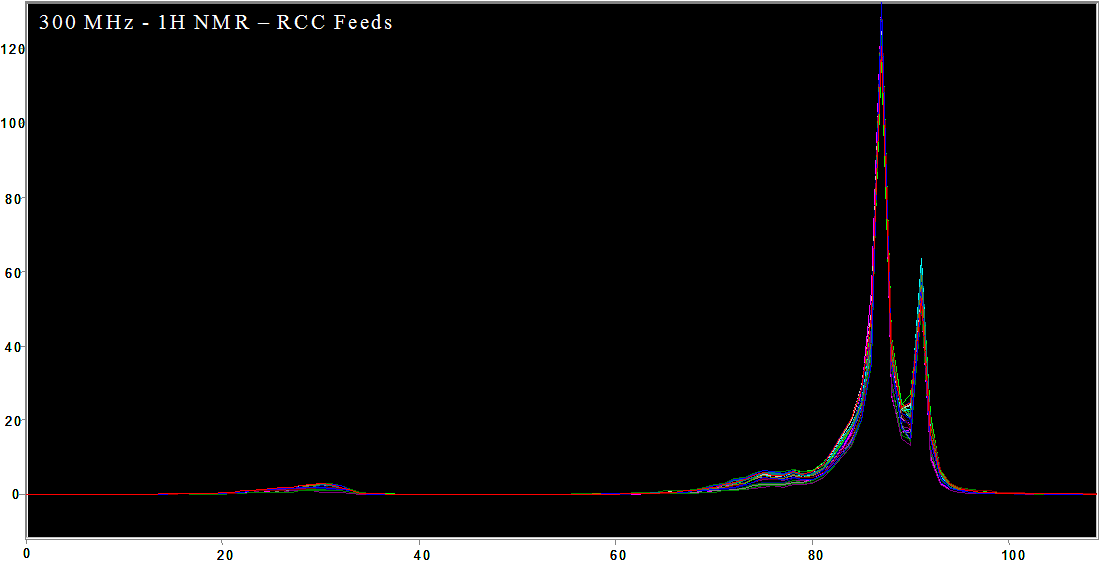
3) Expansions of 1H NMR data on RCC Feeds
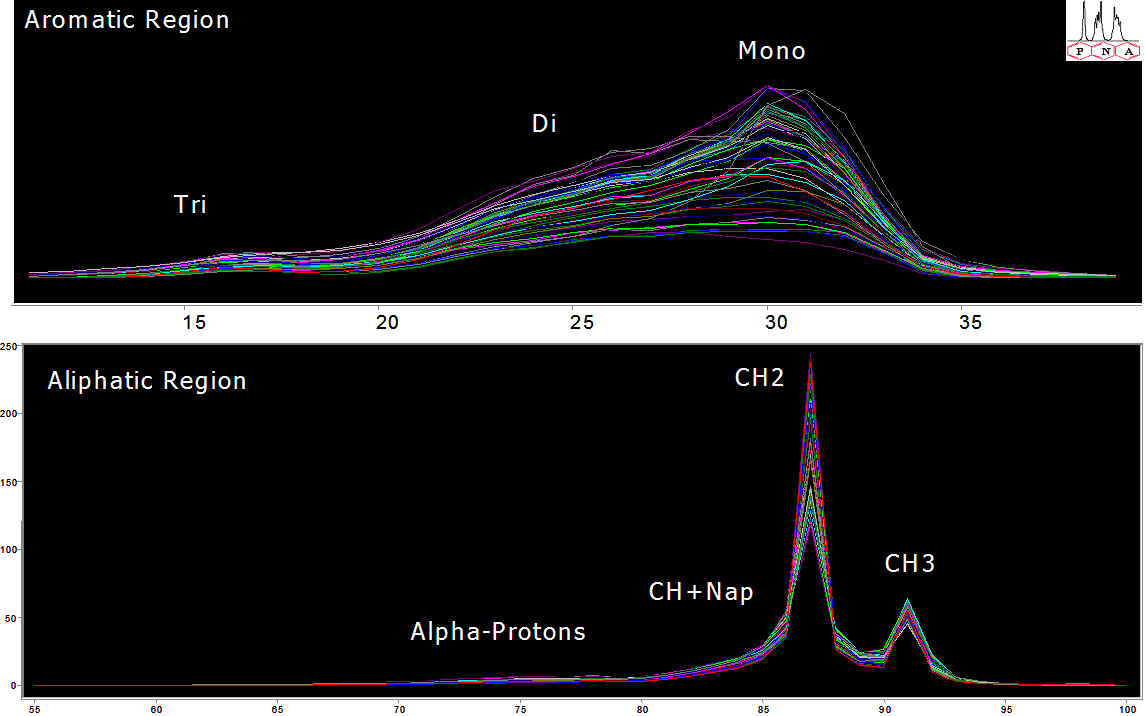
4) Calculated 1H NMR Parameters Represented as an alternative “spectrum” for use in chemometric modeling and linear regression.
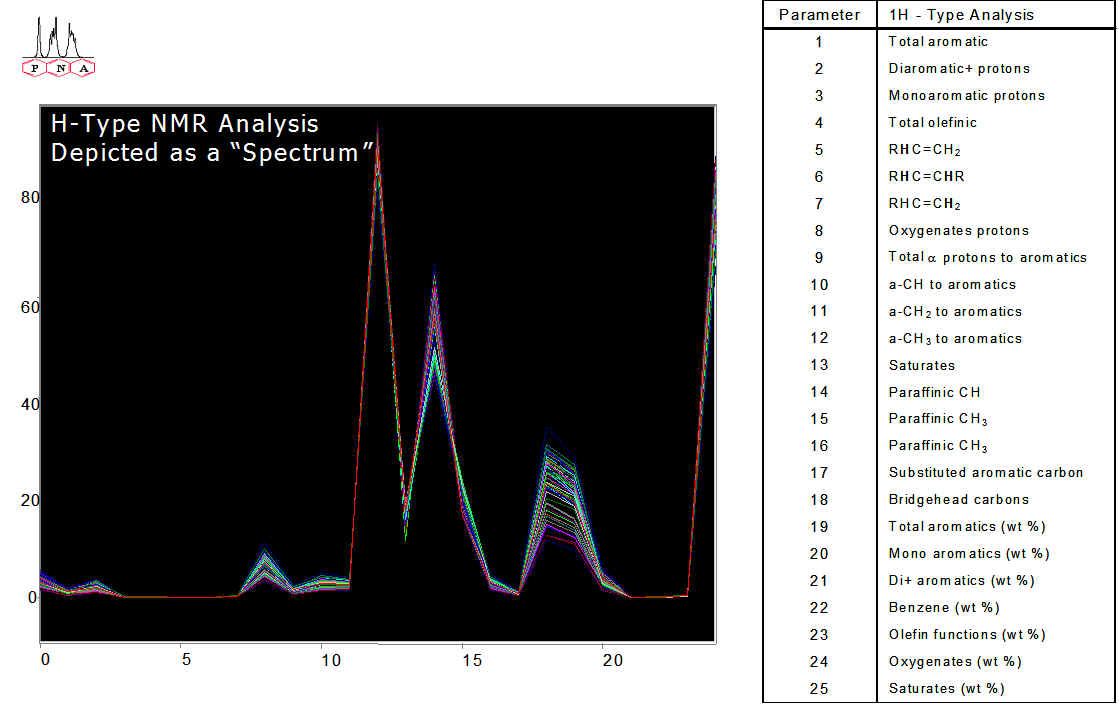
5) 13C NMR Data obtained on RCC Feeds
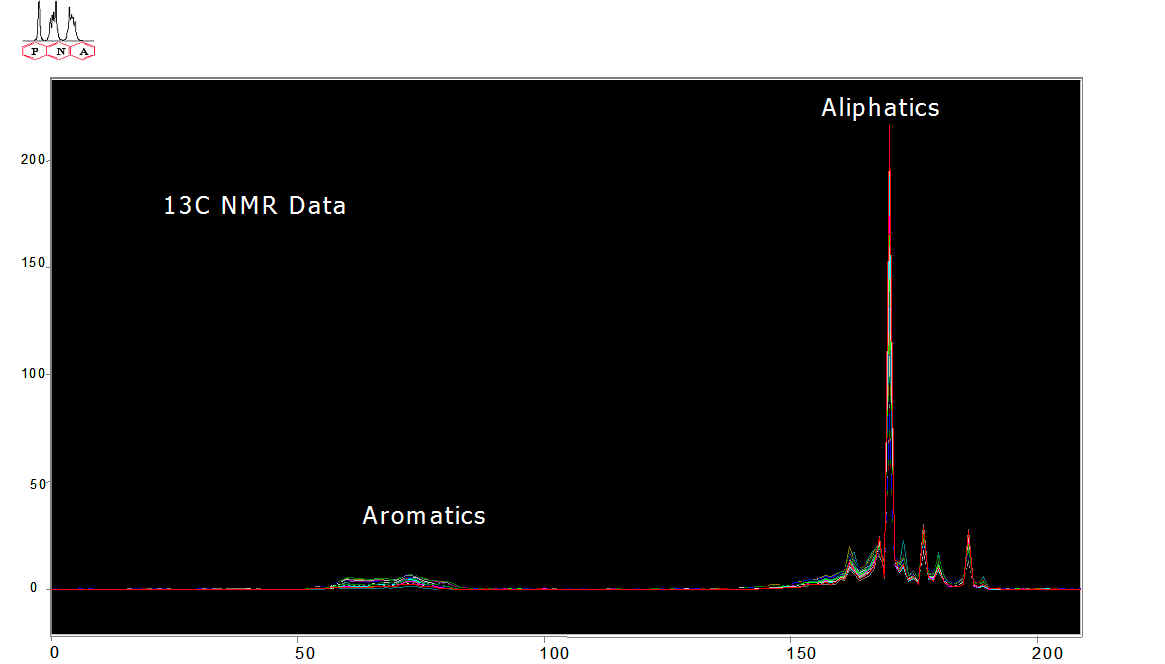
6) Expansions of 13C NMR Data
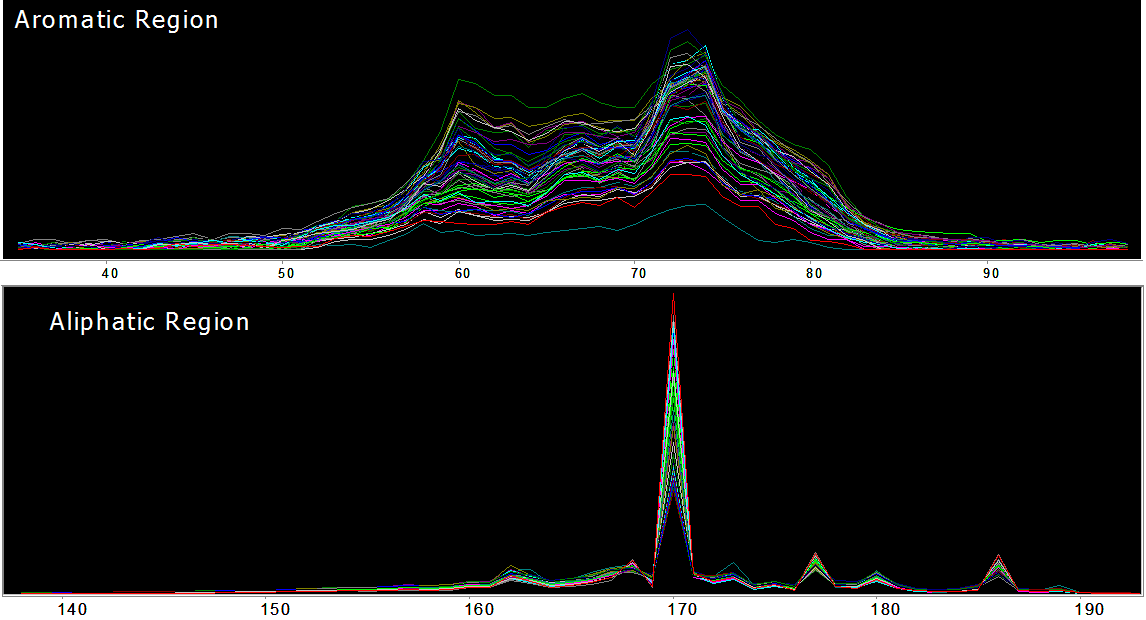
7) 13C NMR and Average Molecule Parameters Calculated from 13C Spectrum
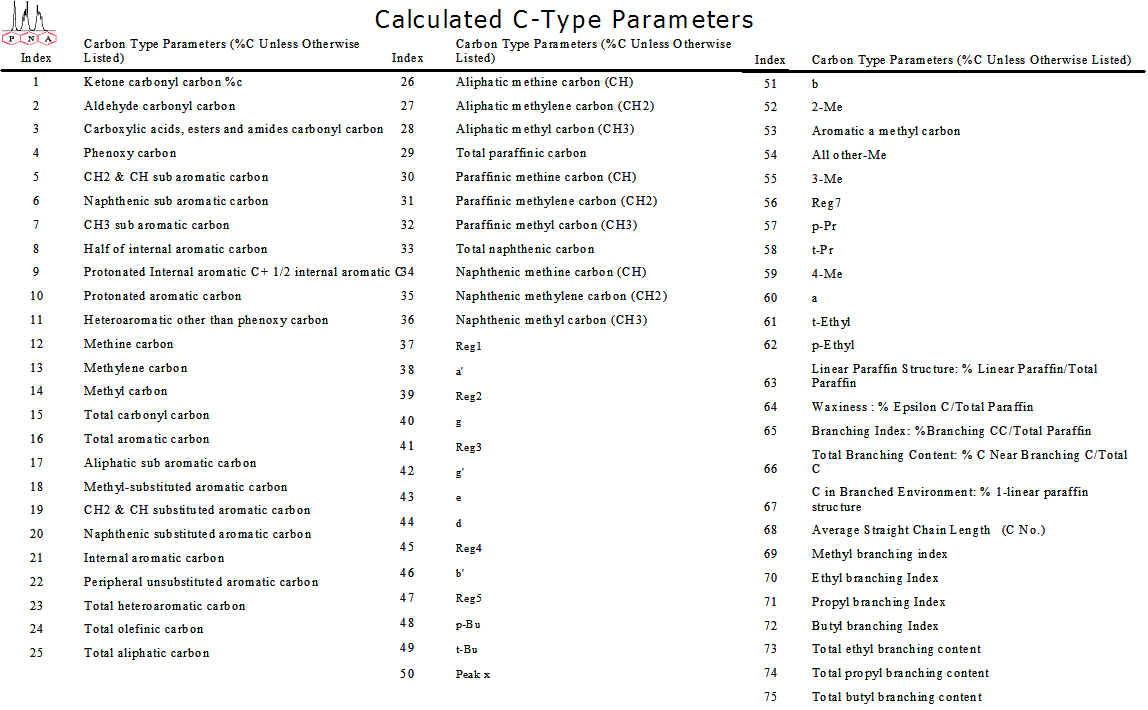
![]() Calculated 13C NMR Parameters Represented as an alternative “spectrum” for use in chemometric modeling and linear regression.
Calculated 13C NMR Parameters Represented as an alternative “spectrum” for use in chemometric modeling and linear regression.
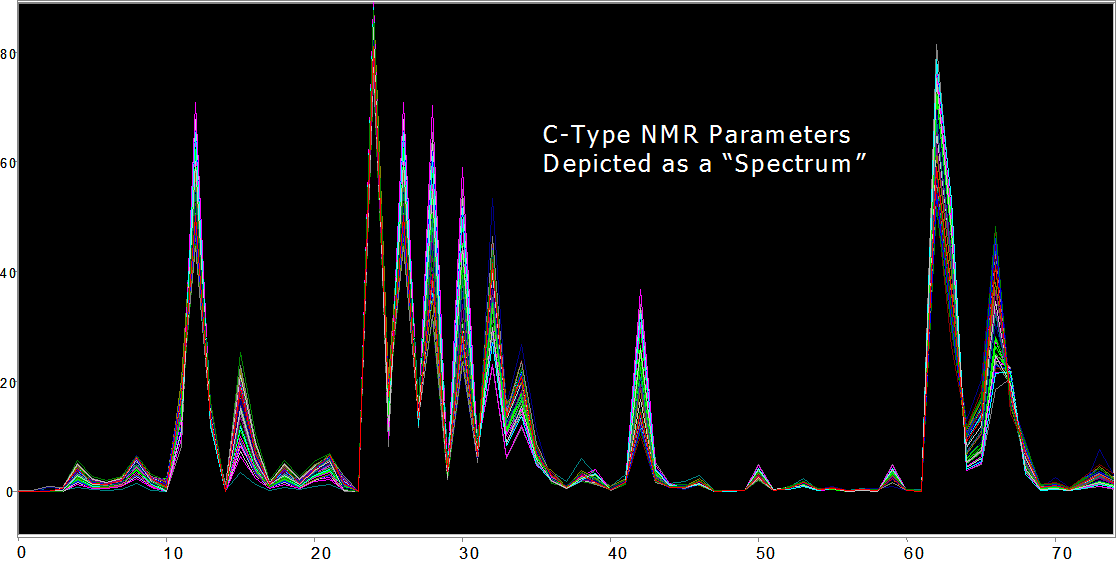
9) Correlations of Spectra and Calculated Parameters to Physico-Chemical properties of RCC Feeds
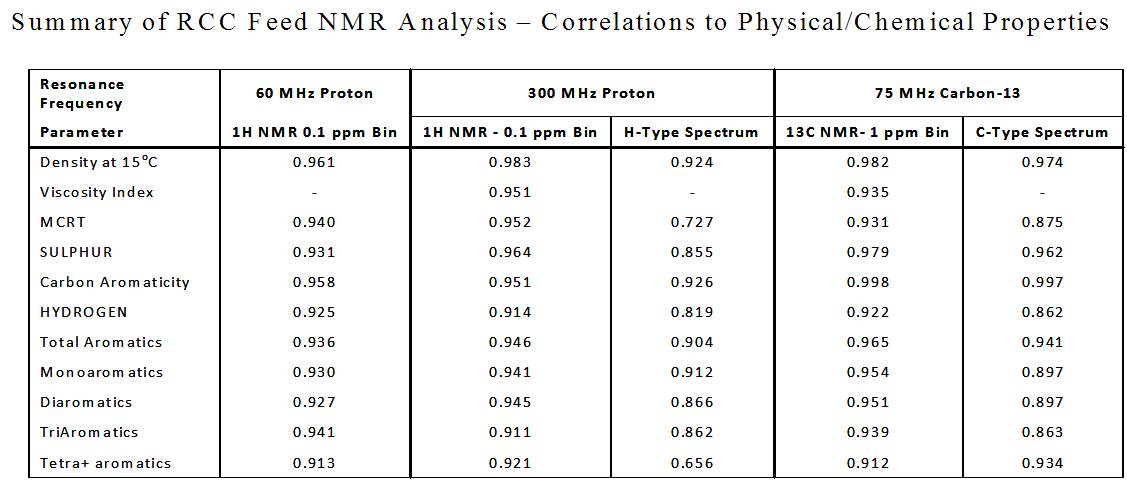
10) Correlation of Spectra and Calculated Parameters to Density
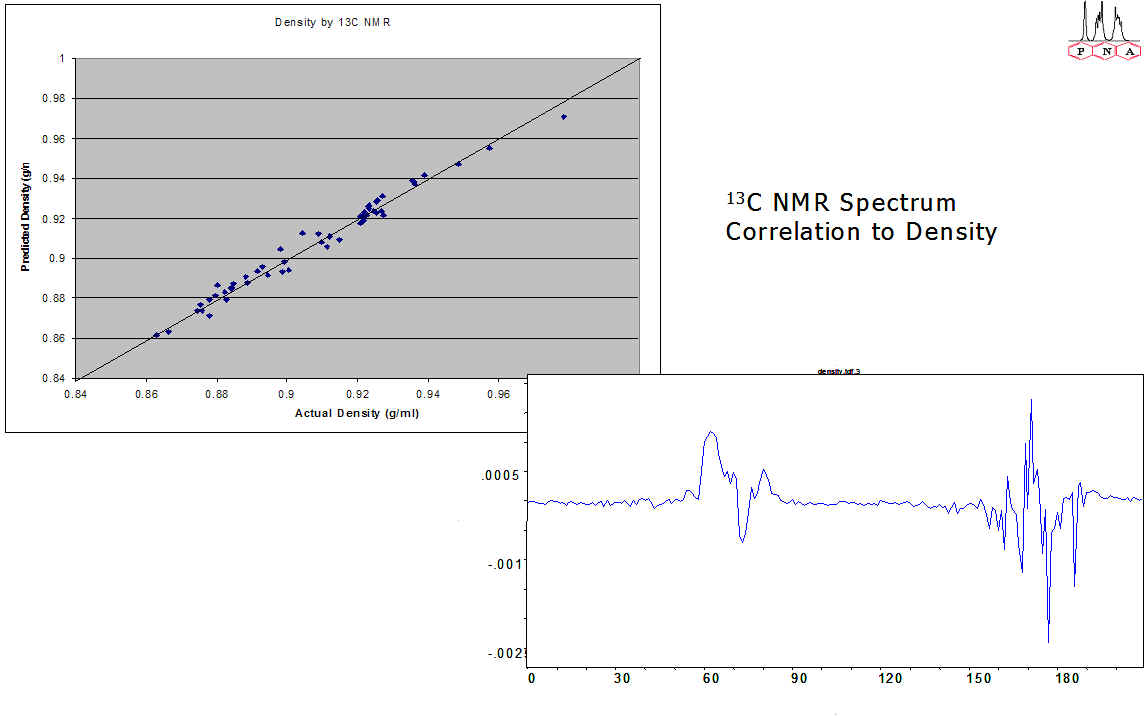
11) Variable Selection for Linear Correlation of Calculated NMR Parameters to Physico-Chemical Properties of RCC Feeds.
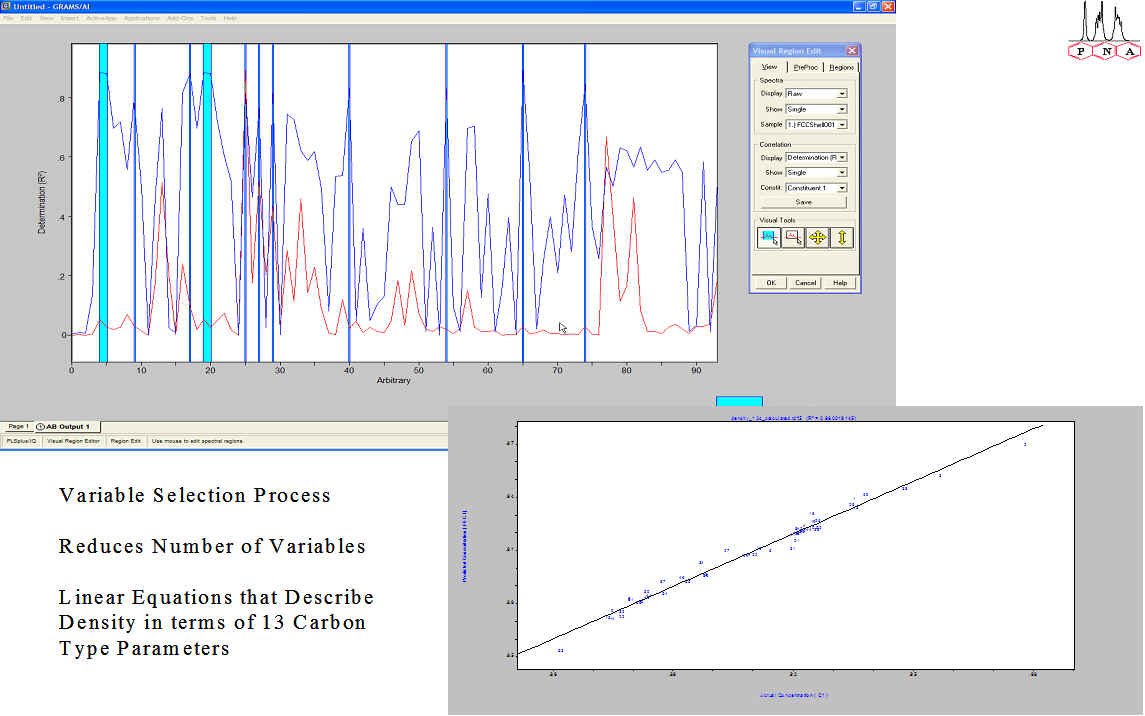
12) Correlation of Calculated 13C NMR Parameters (C-Type and Average Molecule) with both high resolution 1H and 13C NMR spectra. Models created can be utilized by personnel with no NMR experience to calculate NMR parameters directly from the spectrum without any prior knowledge of integrations or calculations to be performed.
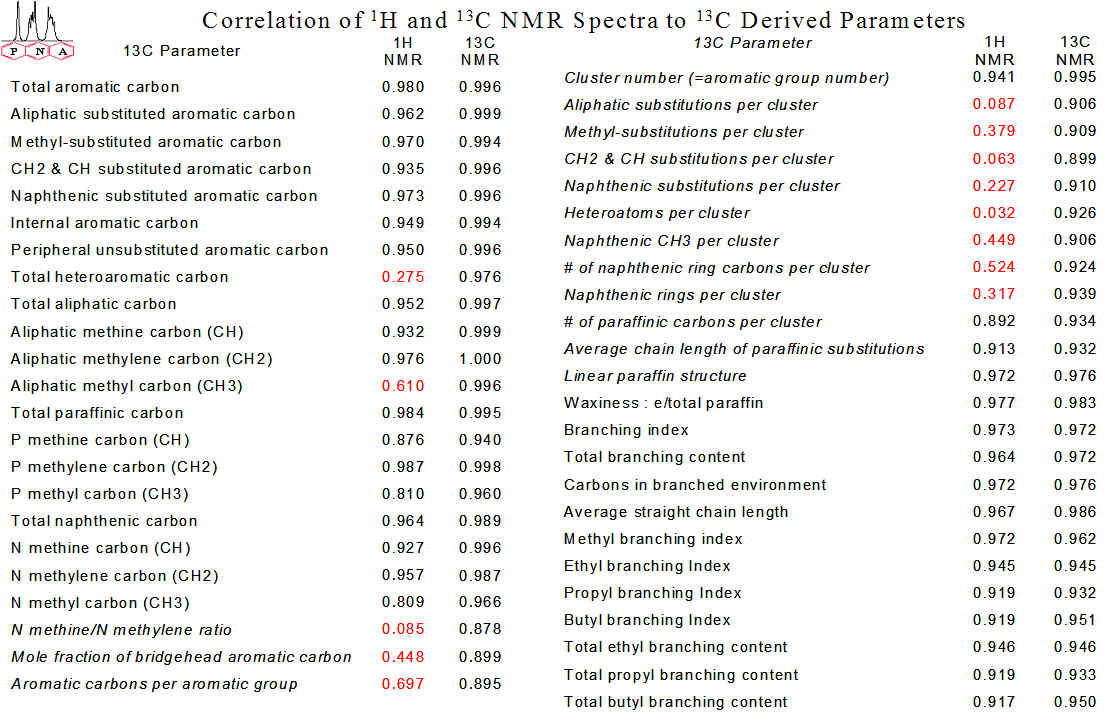
Summary
Chemical and Physical Properties of RCC Feedstreams can be determined
by 1H NMR (at 60 and 300 MHz) and by 13C NMR
H-Type and C-Type Parameters do not provide as good a correlation as is observed
by full spectrum regression. This is due to loss of resolved chemical shift information
when the spectrum is reduced to larger integral areas.
1H NMR can be combined with PLS regression modeling to provide detailed carbon
type analysis for RCC Feeds
Regression analysis of 13C NMR data can be utilized to fully automate the prediction
of 13C NMR type analysis : reducing the necessity for considerable knowledge and
analysis time on the part of the analyst.
For further Detail Contact John Edwards
Diesel Production Control – Combination of NMR and Simulated Distillation to Yield On-Line Carbon Number Distributions
Posted by: processn in NMR, PAT, Process NMR on September 23rd, 2008
Process NMR Associates has developed a database of Simulated Distillation database on a large number of diesel fuels on our Shimadzu 2010-GC with SimDis Software. The analysis is being used to develop distillation prediction models for the process NMR systems as well as explore new avenues of control information that can be derived by combining carbon number distributions obtained from the GC data with the predictive capabilities of online NMR.
For a PDF version of this application article download this: Combination of NMR and Simulated Distillation for Diesel Production Control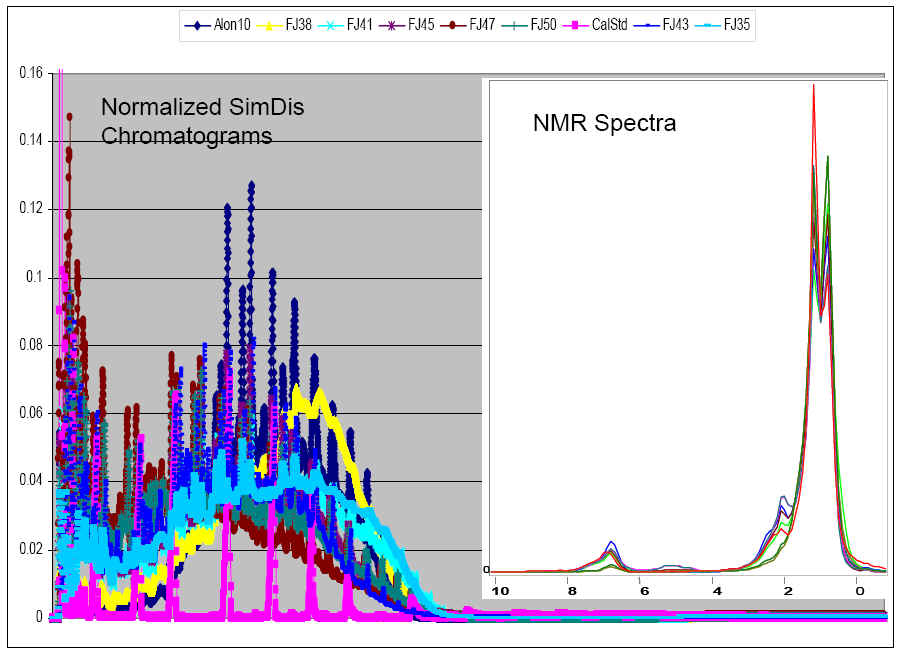
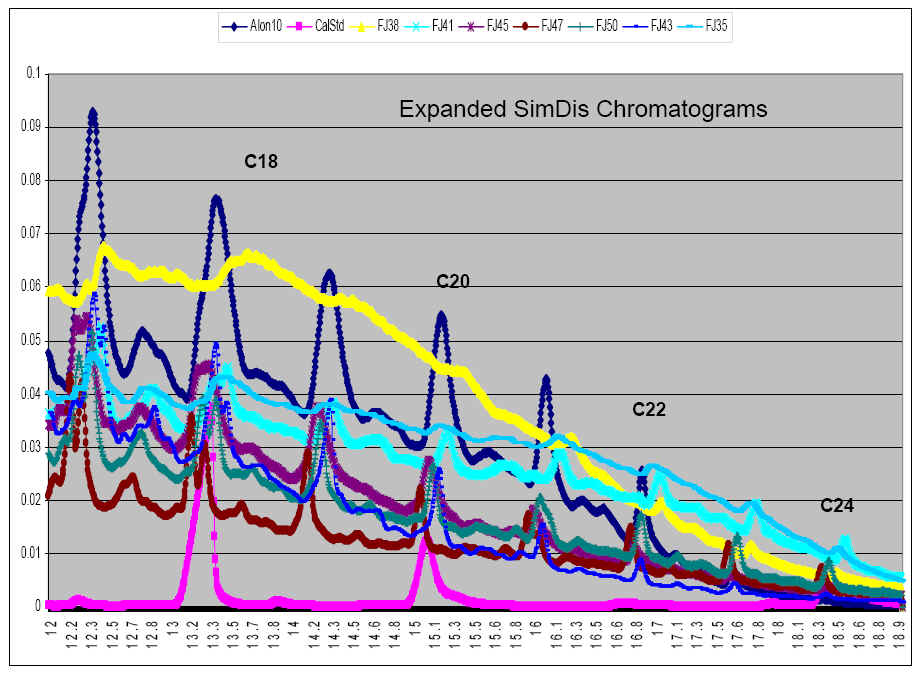
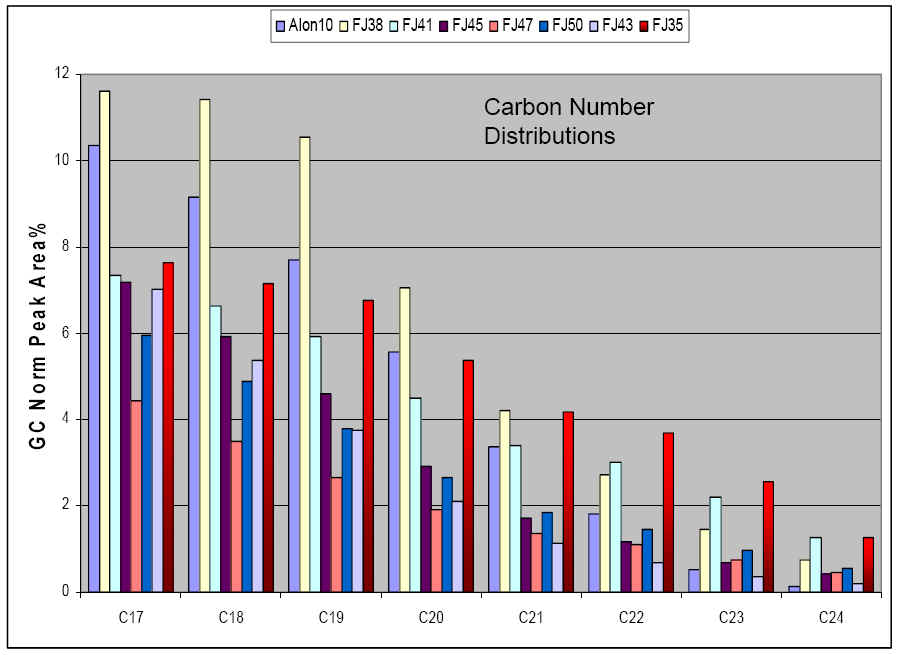
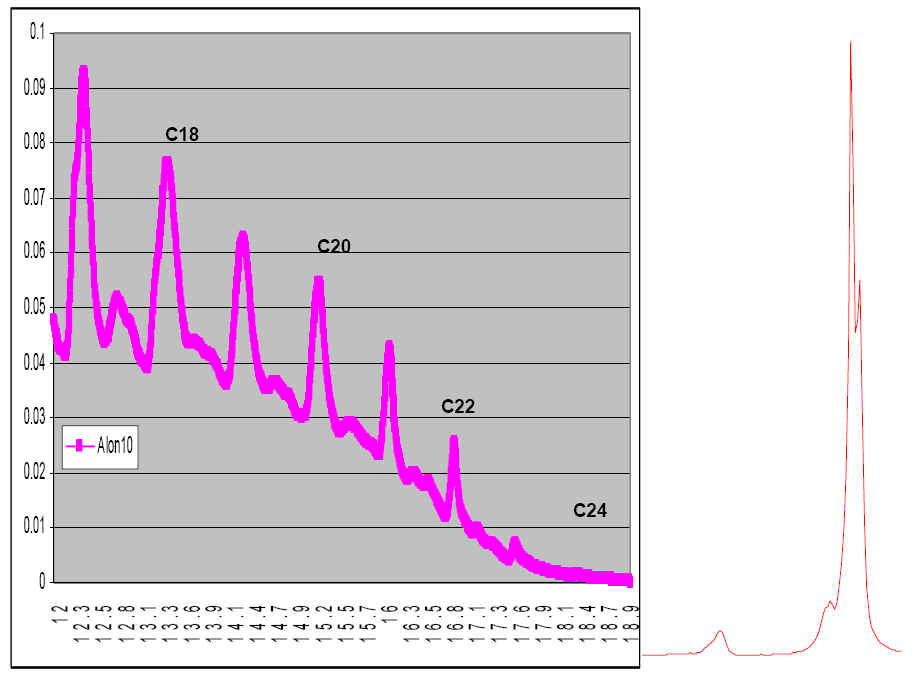
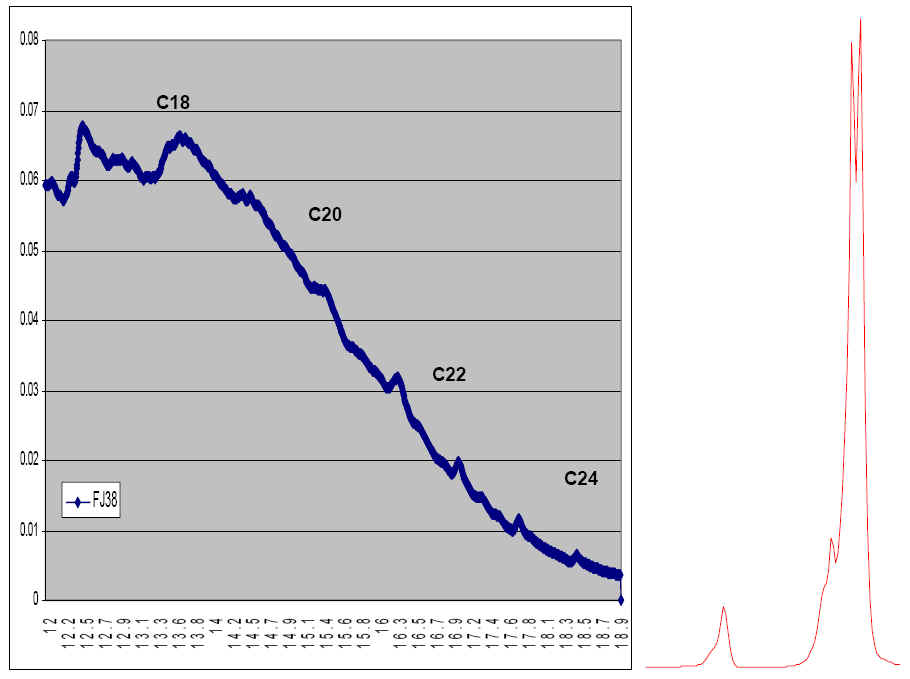
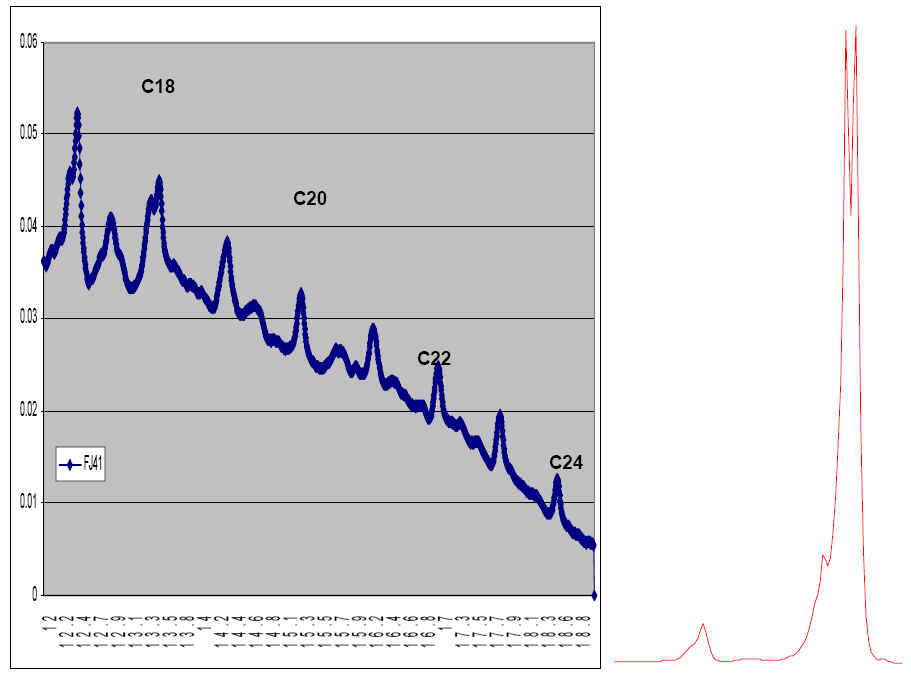
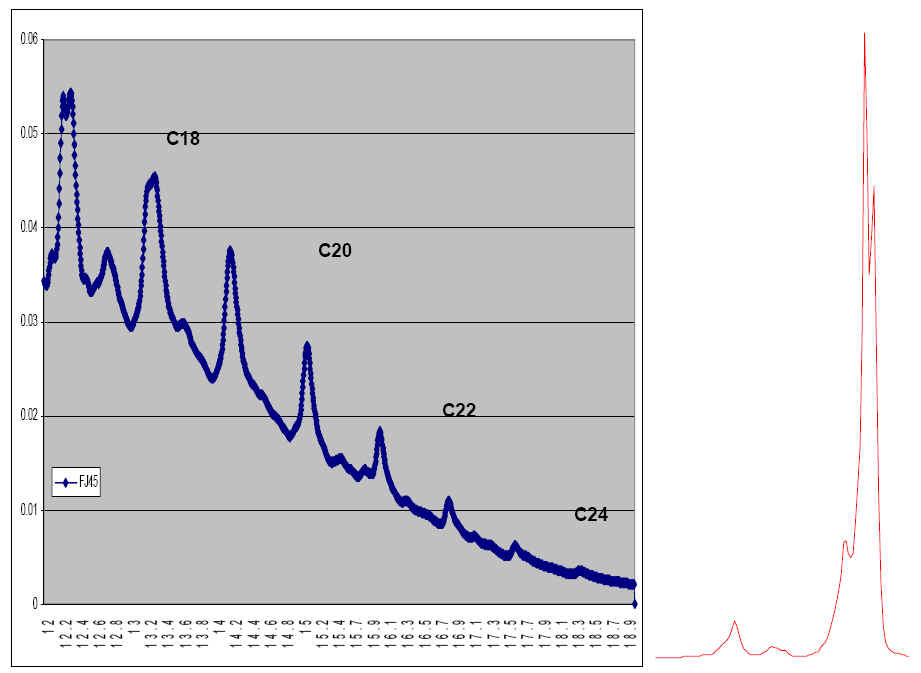
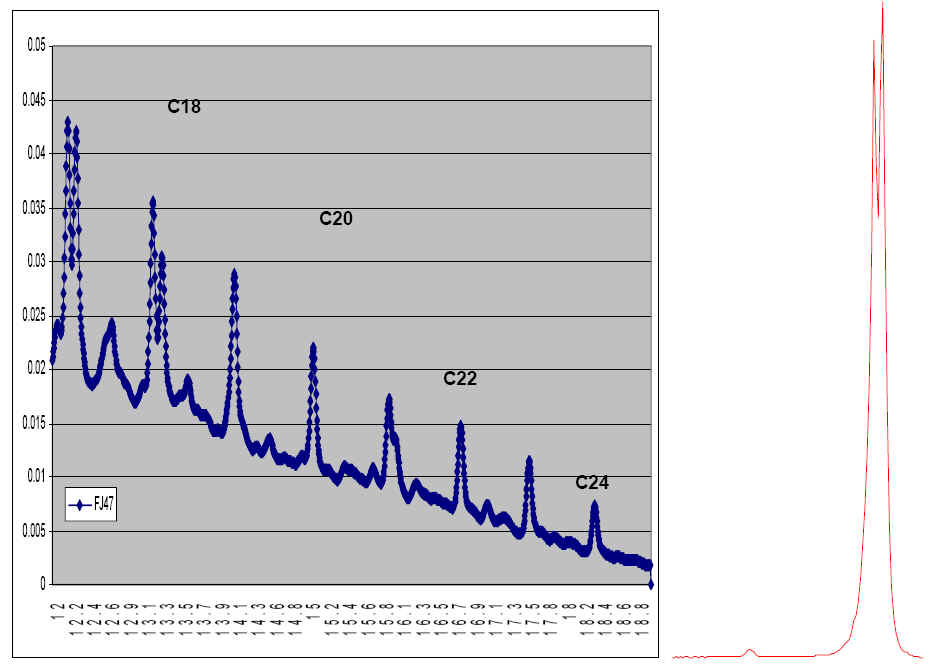
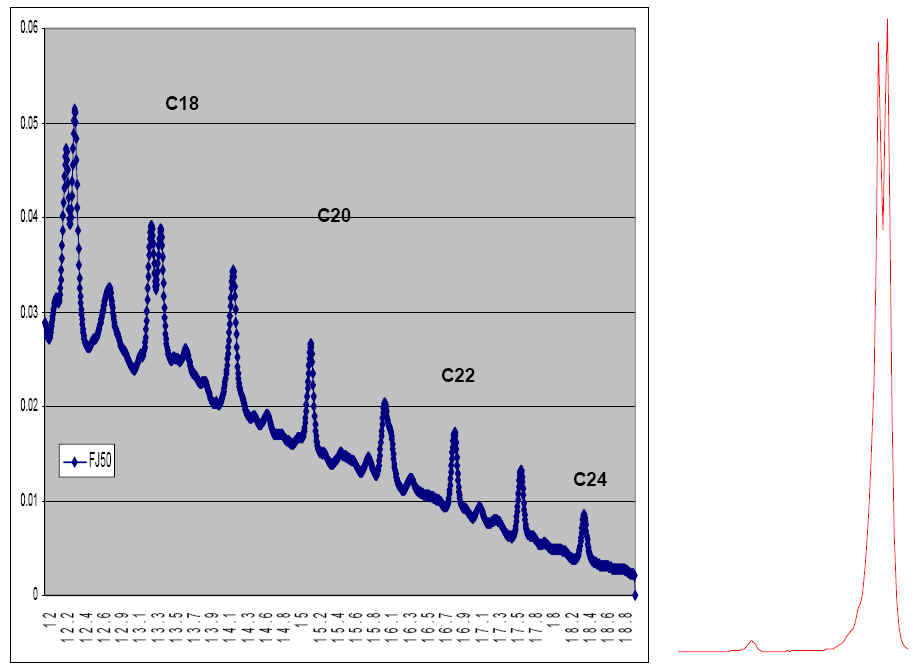
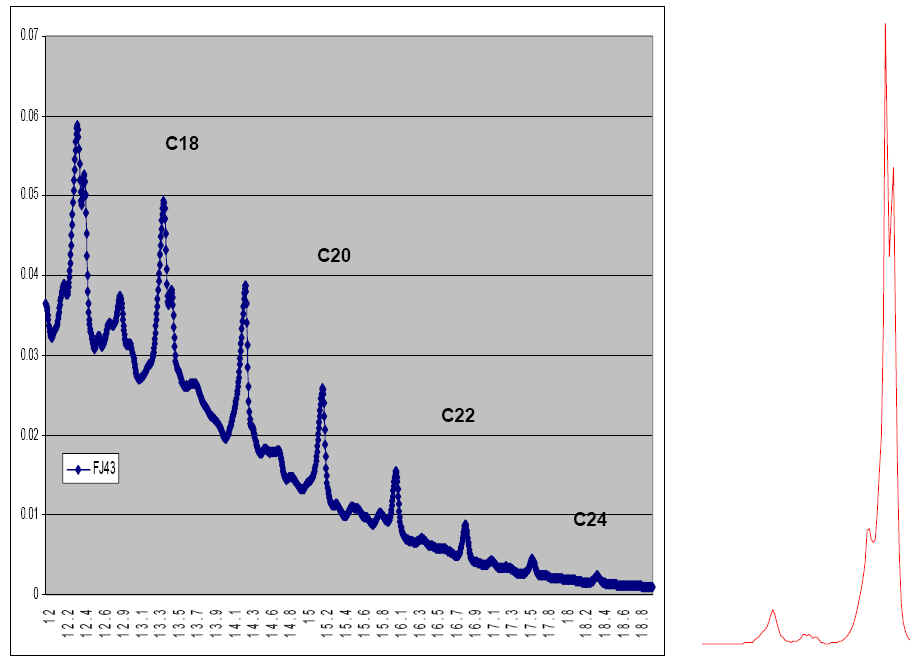
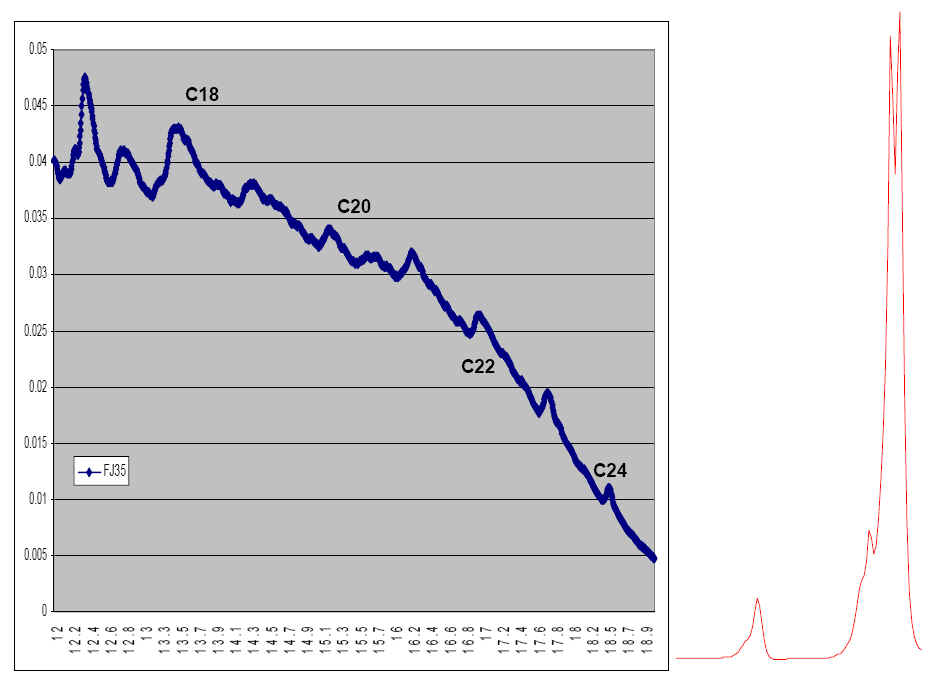
Simulated distillation allows carbon number distributions to be calculated and in combination with chemistry observed in the NMR analysis the effect of aromatics and olefins on the paraffin distributios can be estimated. Online NMR predictions can be established that yield real-time carbon number distributions for production control and sulfur species monitoring.
Contact: Paul Giammatteo Tel: +1 (203) 744-5905
Extensive NMR Diesel Database Enhances NMR Model Performance for Unit Control and Product Manufacturing
Posted by: processn in NMR, PAT, Process NMR on September 23rd, 2008
An extensive database (10 years) of diesel samples incorporating all refining processes (distillation through product blending) enables development of robust, wide ranging property predictions independent of crude sources and refinery processing. Consistent attention to data integrity enables expanding model ranges well beyond any typical single unit or process operation. The following slides elucidate the consistency in spectra whether obtained 10 years ago or last week, from within a refinery or on a laboratory spectrometer.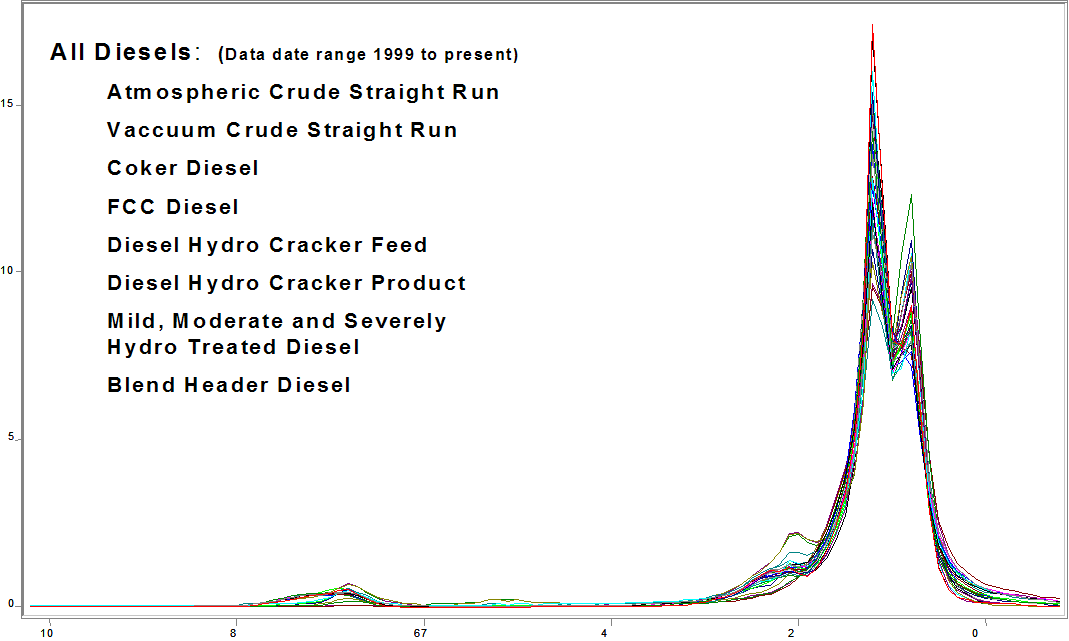
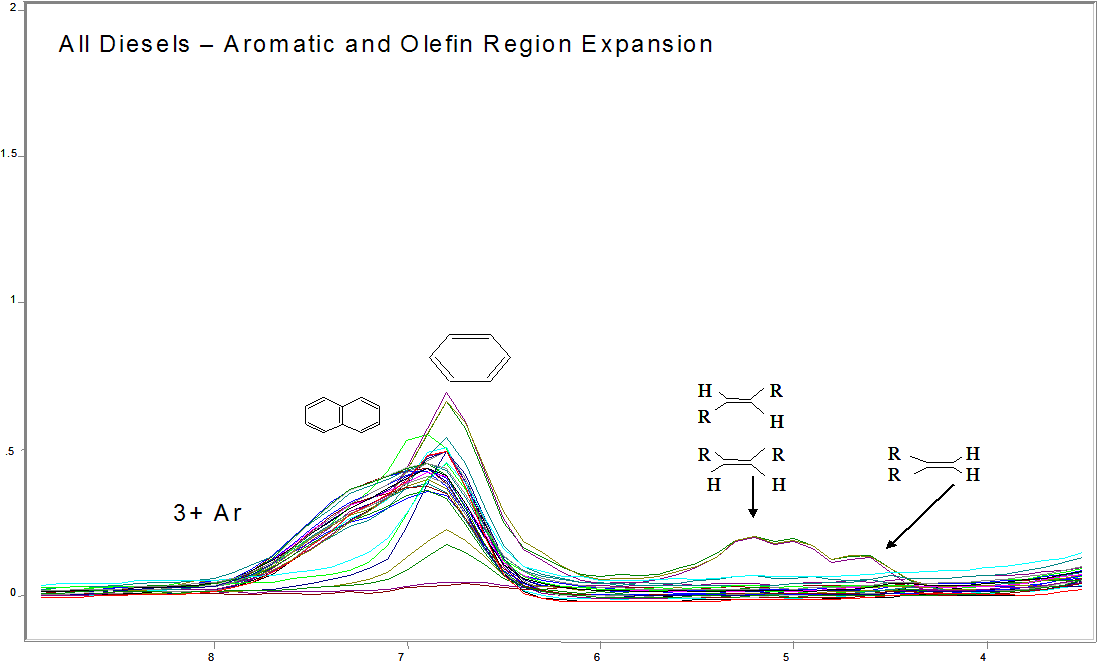
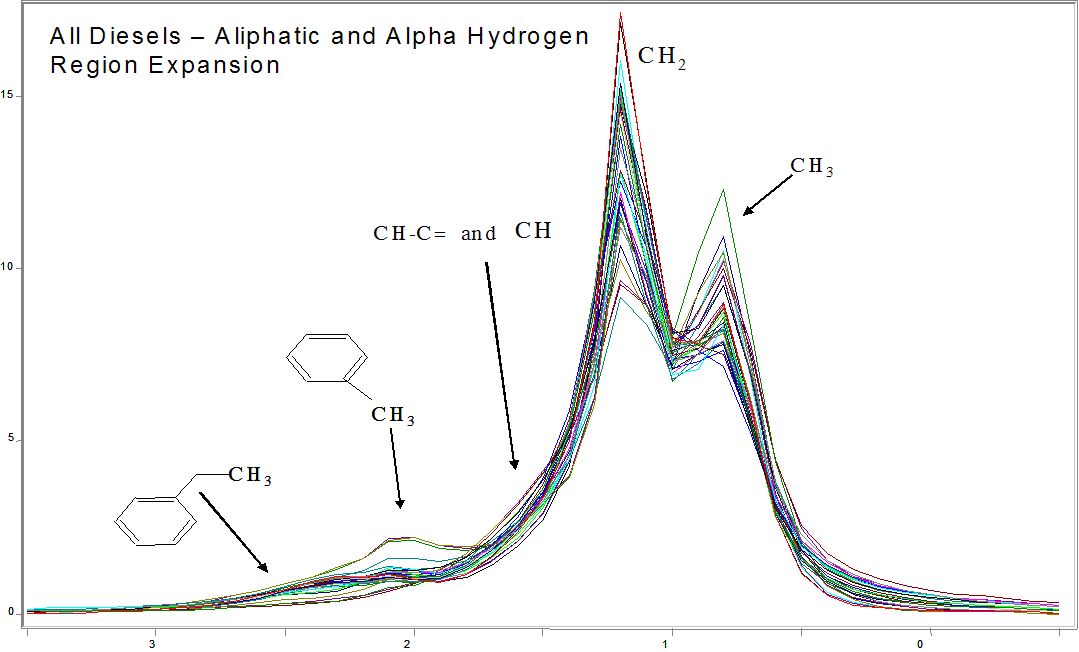
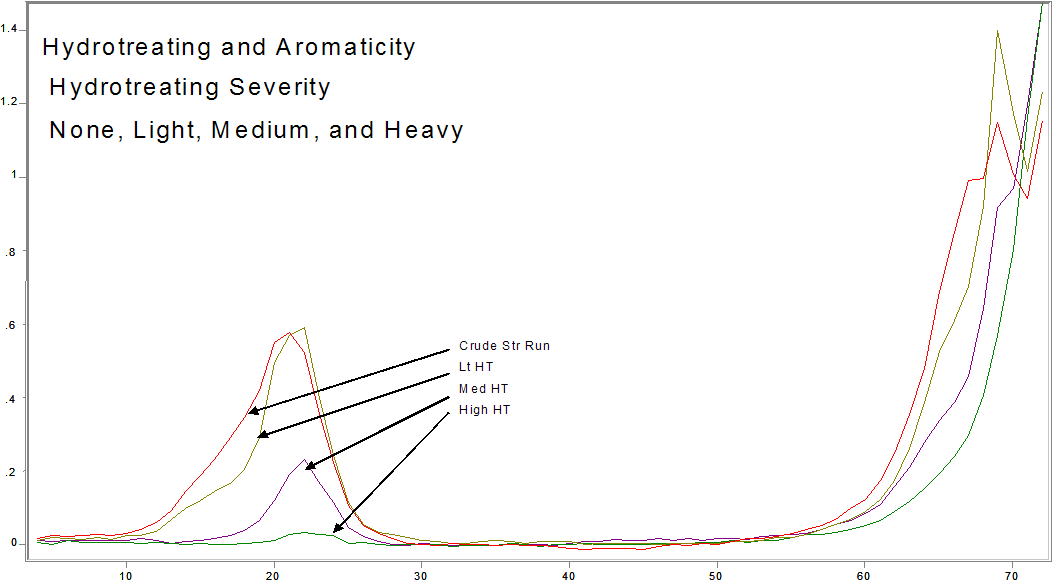
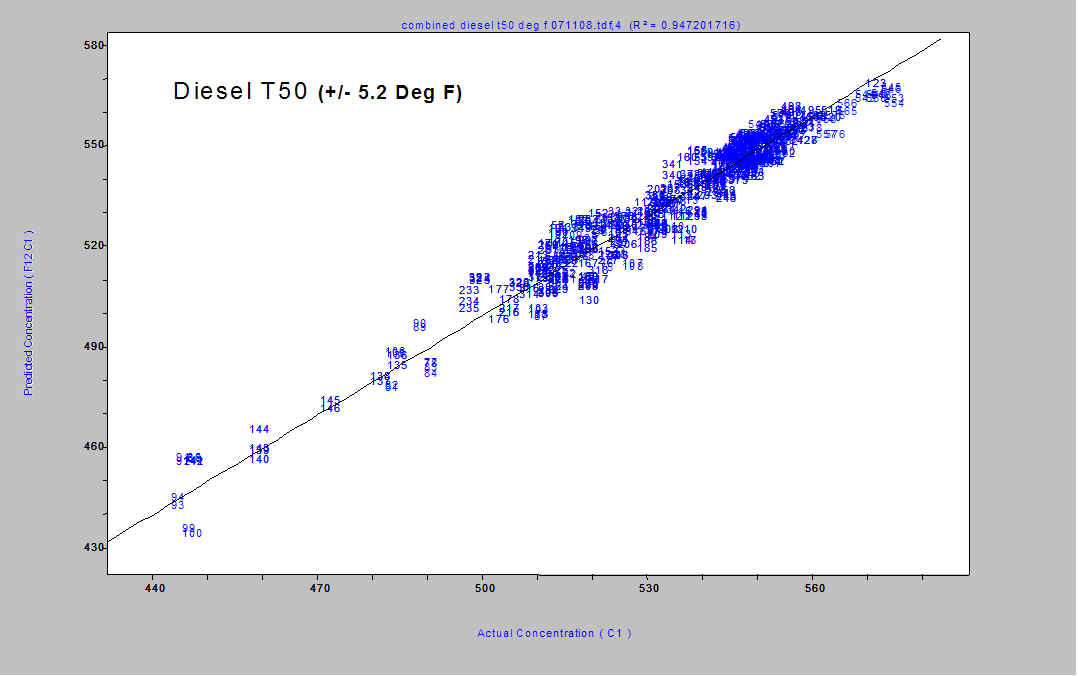
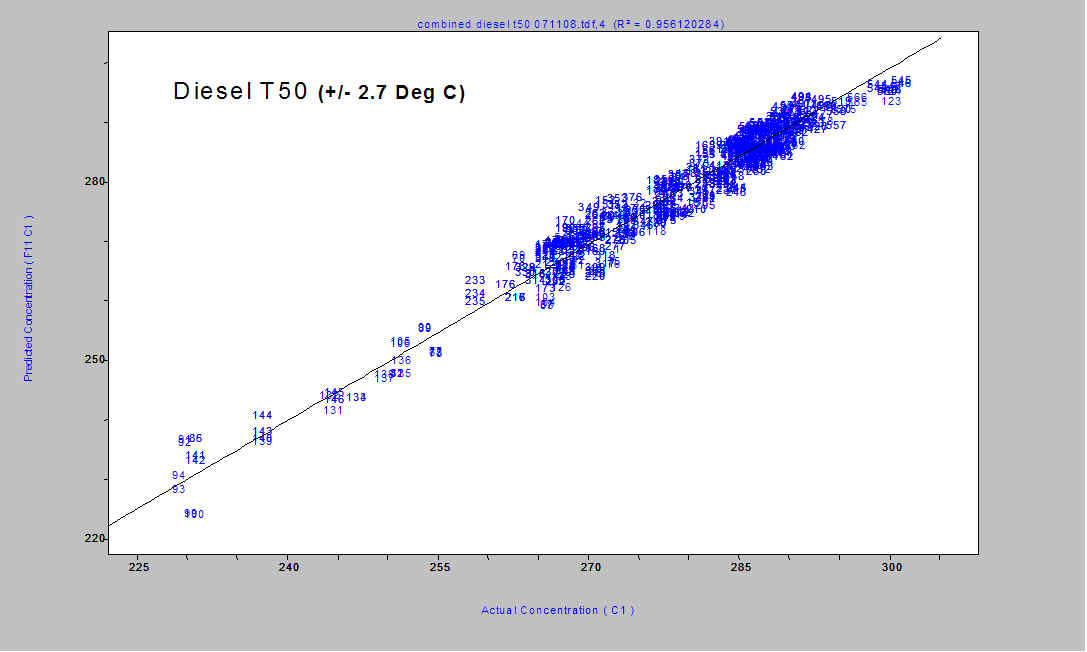
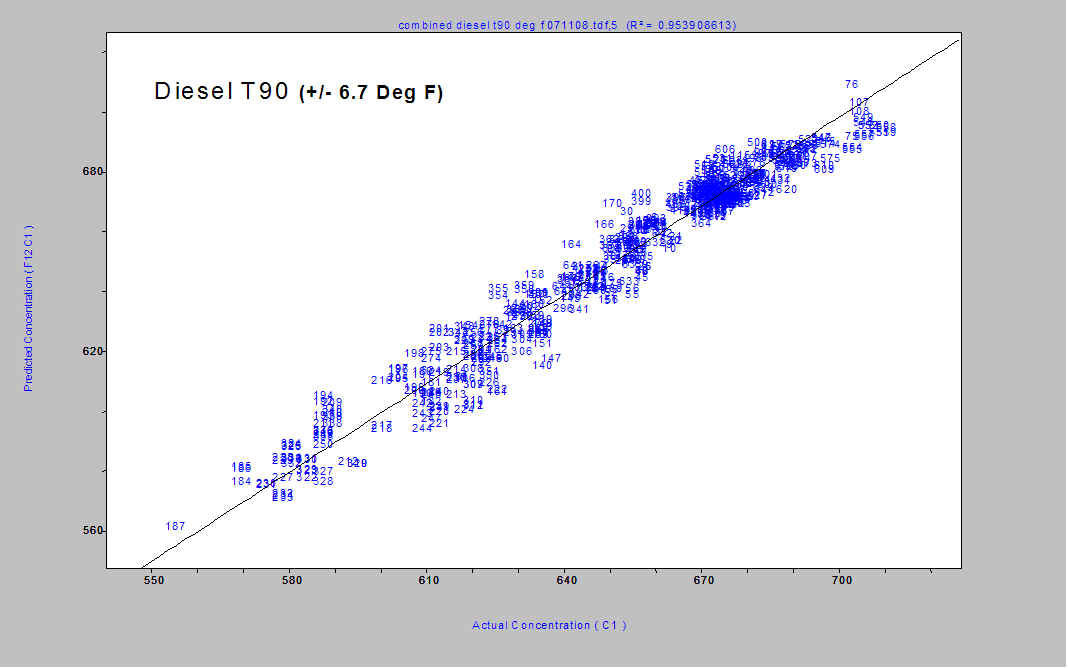
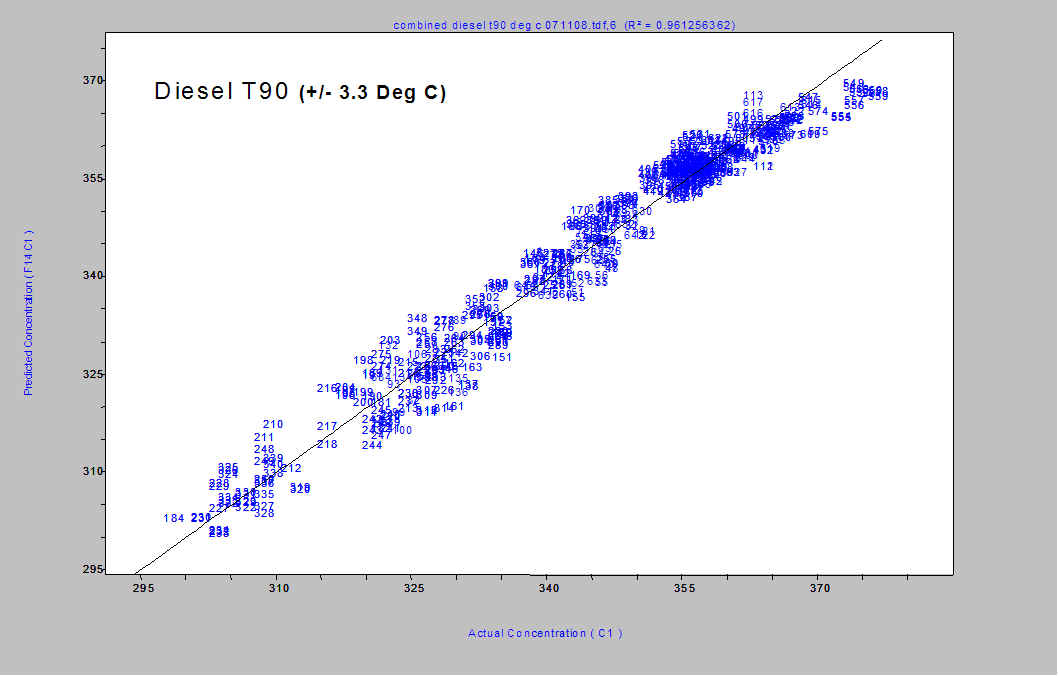
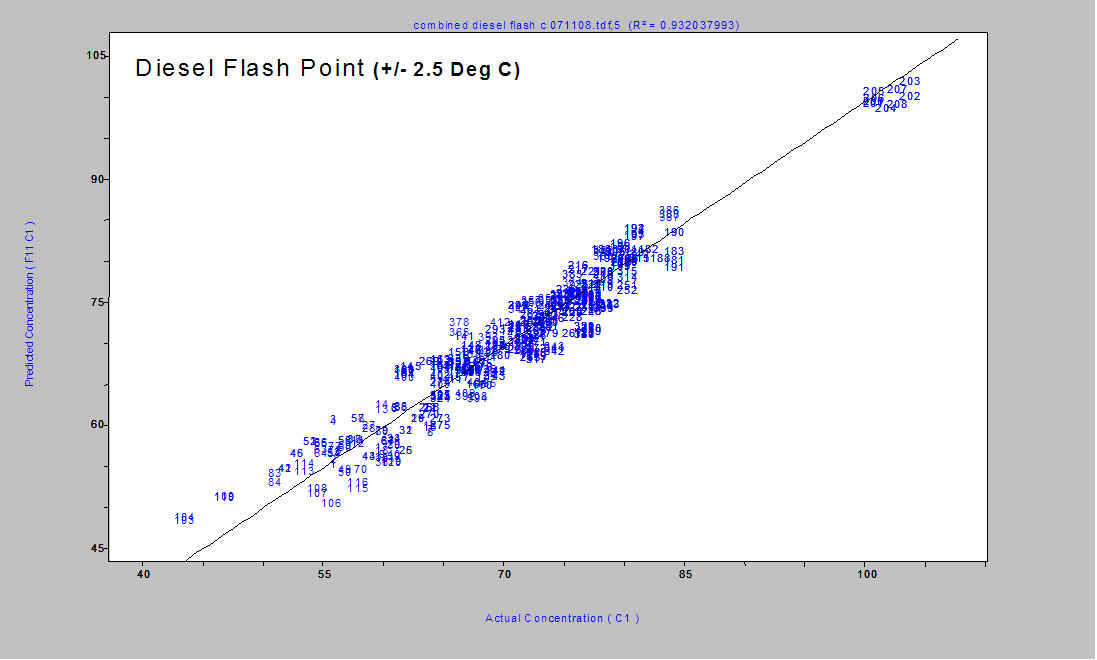
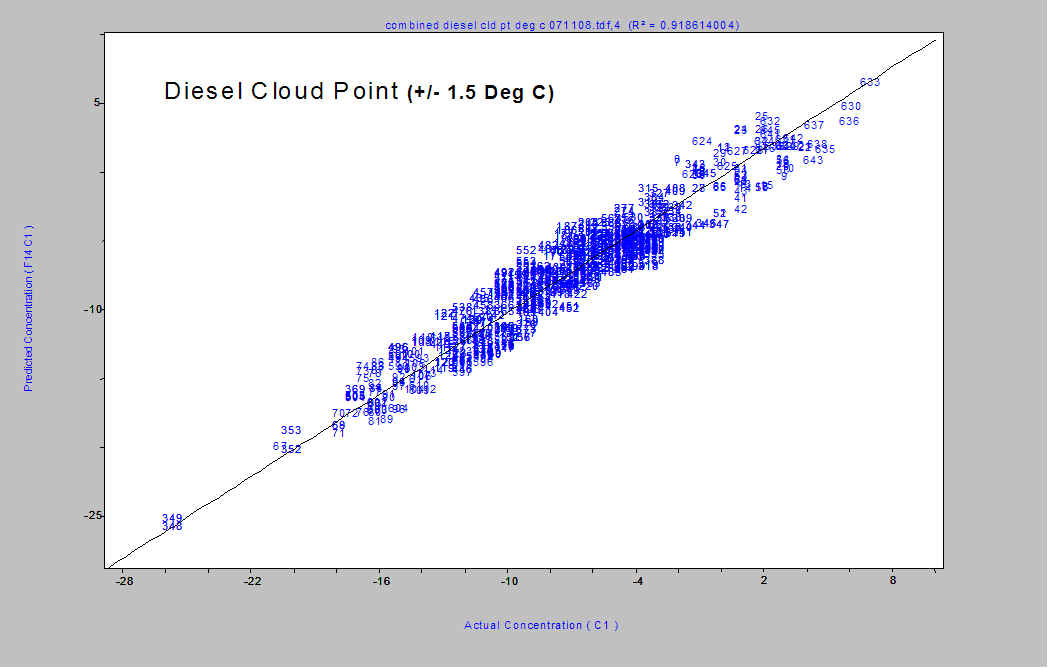
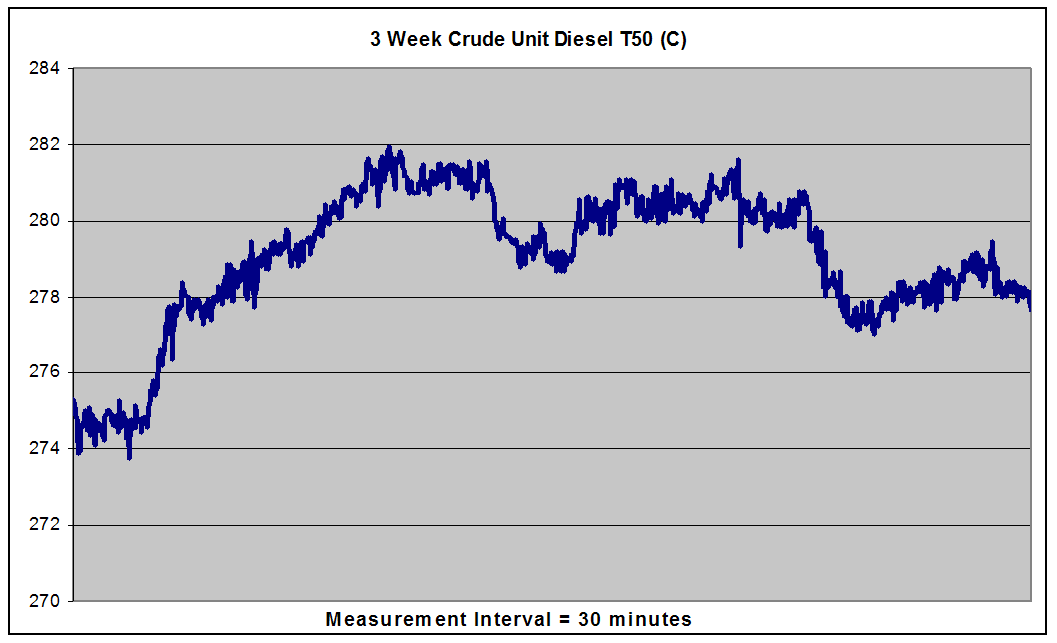
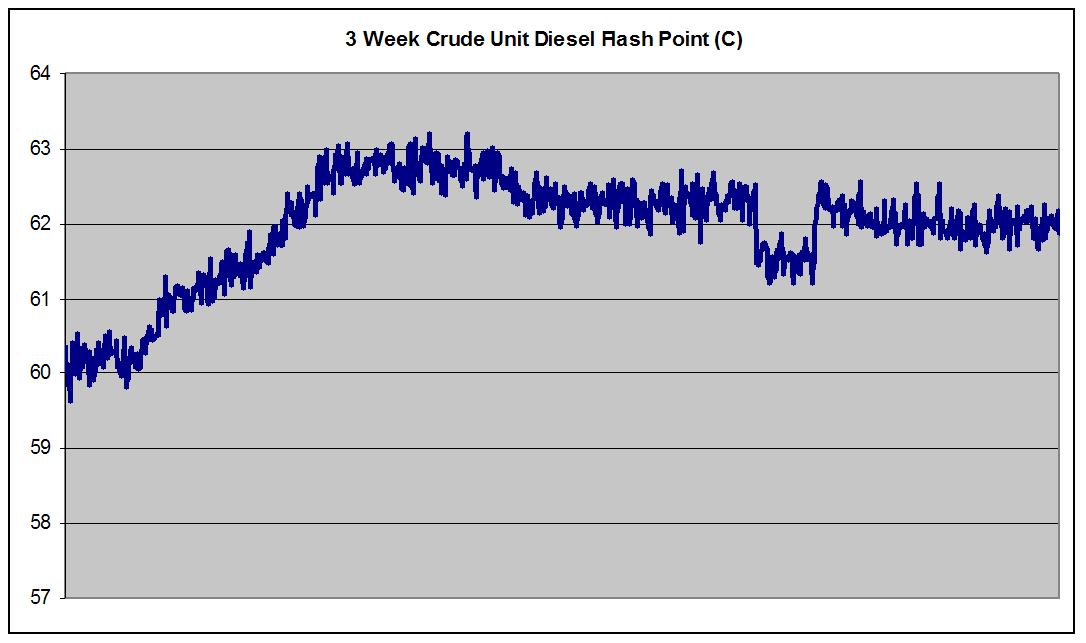
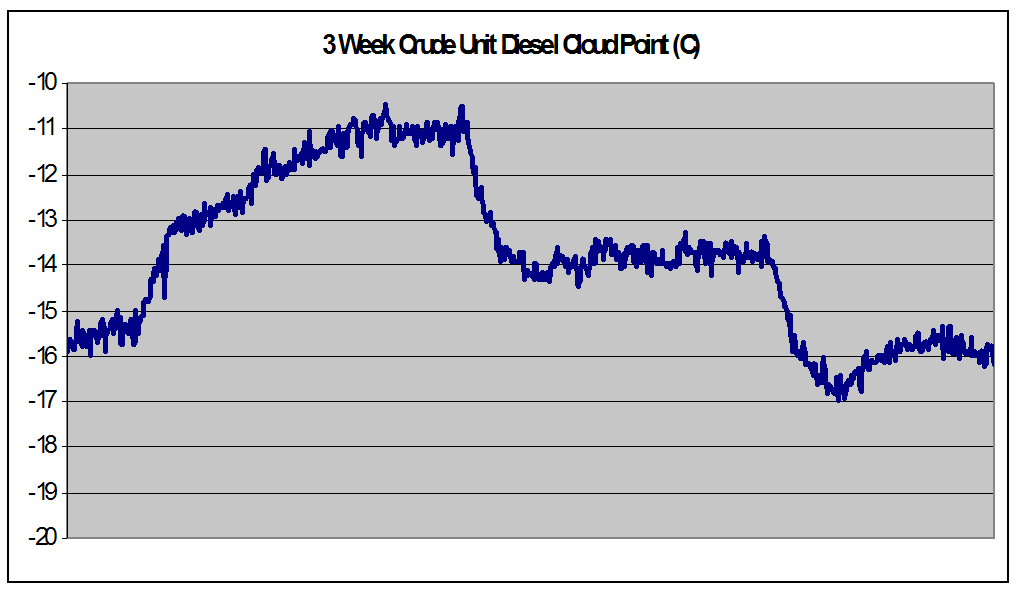
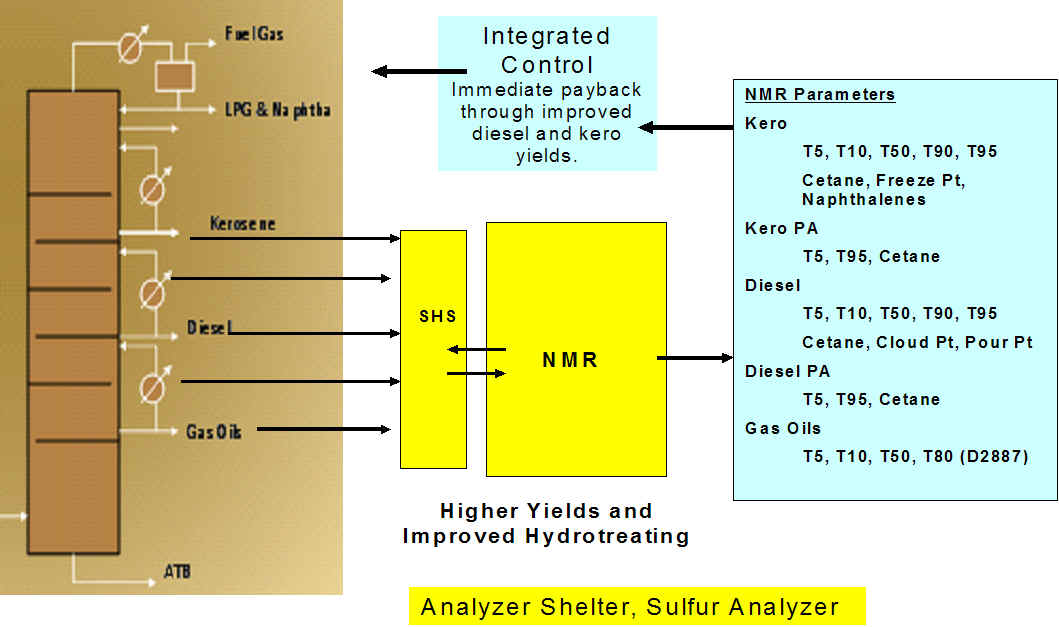
If you are interested in finding out more about NMR and diesel production control contact Paul Giammatteoor phone him at +1 (203) 744-5905 – see the Process NMR Associates website for further information
Quantitative NMR Analysis of Wine – qNMR
Here is an example of a 1H NMR analysis of a 2007 Red Wine submitted for chemical analysis by John W.


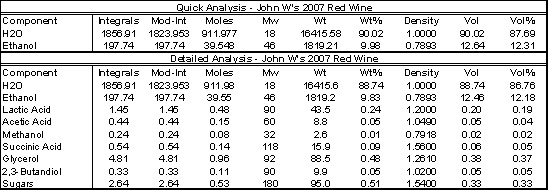
If you are interested in wine analysis please contact us.
Solid-State 13C NMR Analysis of Carbonaceous Materials
Over the past 20 years we have obtained the solid-state NMR analysis of pretty much every carbonaceous material that exists – including coal/oil shales/bitumen, polymers/catalysts/fibers, cellulose/polysaccharides/foodstuffs/gels, deposits/dried sewage/meteorites/soils/clays, etc. With the increased attention to coal liquifaction and gasification technologies we have developed an interest in creating an NMR database for coals. Coals were obtained from the Penn State Coal Sample Bank at a very reasonable cost. We have performed CP-MAS, DD-MAS, Variable Contact Time, and T1 inversion recovery experiments on all the samples. We are currently developing regression relationships between the NMR data and the physical and chemical testing data that is provided with the samples. At some point we will write this up as a journal article. Here are some snippets of data from the coal analysis along with a few results obtained on the menagerie of samples we look at on any given day including some oil shales, engine deposits, refinery coke, asphaltenes, and pipe tobacco.







Please inquire if you are interested in the details of the above analyses.
60 MHz TD-NMR System
Process NMR Associates and Spin Resonance Ltd have recently completed the construction a small 60 MHz (1.4T) 5mm TD-NMR system that can be utilized to study T1 and T2 characteristics of novel contrast agents at typical MRI frequencies. Here are a few pictures of the magnet. It is based on N42 neodymium-iron discs (120mm diameter x 30 mm deep).



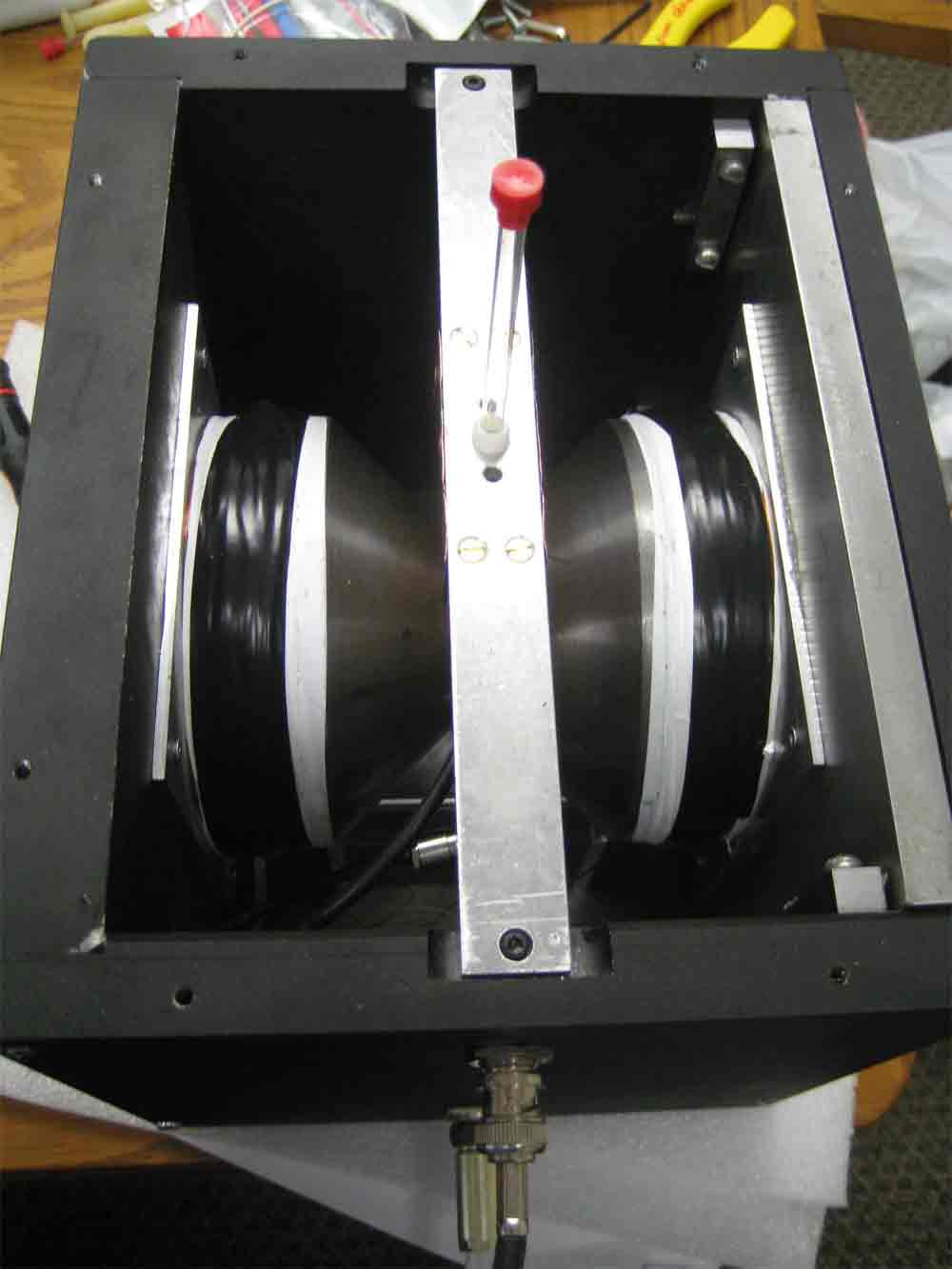
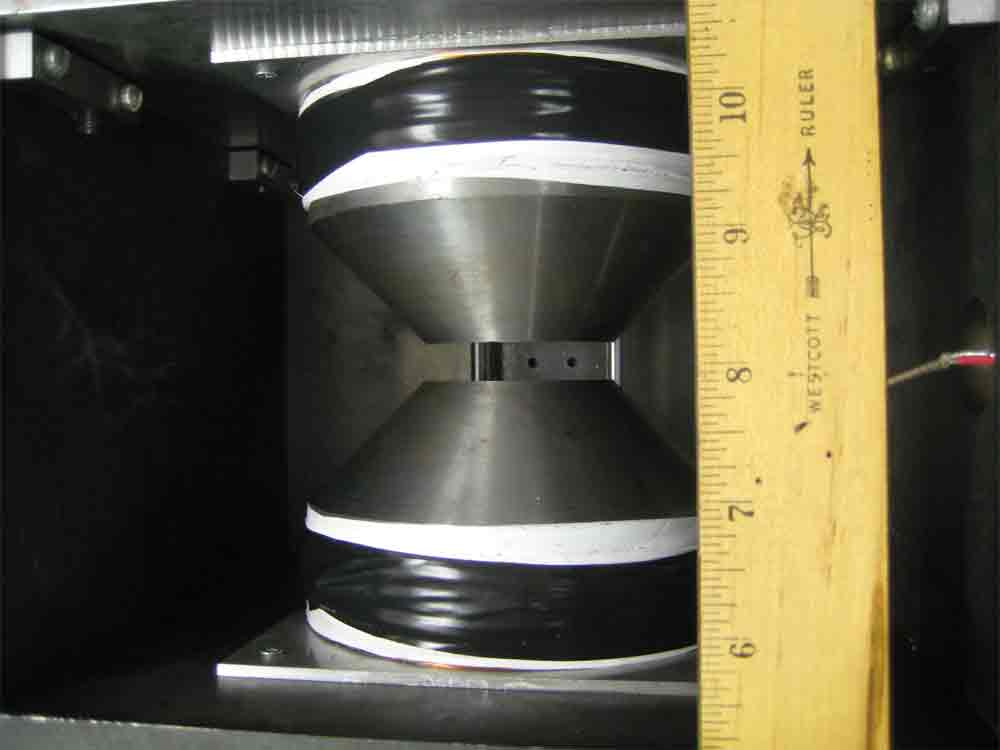
Process NMR Application: Spectro-Molecular Control for Enhanced Diesel Recovery
Posted by: processn in Energy, NMR, Process NMR on February 28th, 2008
NMR Process Systems – Integrated Solution
Application for Crude Unit and Downstream Processes:
Spectro-Molecular Control for Enhanced Diesel Recovery
NMR Process Systems (NPS) on-line NMR based analytical and process control strategy for enhanced diesel recovery at the crude distillation unit maximizes clean diesel recovery by enabling closer cut point control in the mid-section of the CDU.
Clean Fuels regulations in both the European and American markets have had a substantial impact on a refiners ability to maximize product draws at the refinery front end. Extremely low sulfur requirements for gasoline and diesel have resulted in refiners now being more constrained at the hydro-treaters. Lack of reliable, focused, measurement and control of critical CDU product draws has forced many refiners to significantly undercut these draws in order to ensure minimum error in the final product blends, especially with respect to total sulfur. Depending on a refinery’s crude supply and CDU capacity, a conservative estimate of 300-500+ barrels per day of loss diesel production is typical. With an average of $25-$35 per barrel margin loss, the economic impact of these Clean Fuels Regulations are substantial.
Integrating proven NMR technology with a focused measurement and control strategy enables crude unit operations to cut chemically closer to the hydrotreater constraint limit. The strength of NMR is that it quantitatively and accurately observesthe chemistry of each refinery stream and readily relates that chemistry to chemically dependent parameters such as distillation, cetane, freeze points, etc. The NPS strategy is to cut and control CDU diesel production as closely to the dibenzothiophene distillation limit as possible. Figure 1 illustrates this strategy in terms of both current and proposed NMR based measurements.
Figure 1: Overall NMR measurement and control outline highlighting measurement/control strategies.

Let NMR Process Systems deliver Spectro-Molecular Control to your refinery so that you can achieve real economic and production benefits.
Process NMR Associates – Archives – Gasoline Analysis by NMR and Chemometrics – ENC 1996
Posted by: processn in Chemistry, NIR, NMR, Process NMR on January 28th, 2008
Just came across an old presentation on gasoline analysis by NMR and chemometrics with direct comparisons to Mid-IR and NIR. Presented at the Experimental NMR Conference in March 1996….PDF (3 MB)
Conjugated Diolefins Analysis by COSY NMR
Conjugated diolefins are responsible for fouling of many processes in a refinery. COSY NMR analysis can determine the concentration of these species in many processed petroleum product streams….see PNA webs site.




Schering-Plough Corporation Seeks Process Analytical Technology Manager
Title:
Process Analytical Technology (PAT) Manager
Description:
Implement Process Analytical Technology (PAT) throughout all the Global Quality Sites to identification of incoming materials and monitor manufacturing processes.
Work directly with the sites and Schering Plough Research Institute to help support / initiate the development, validation, and deployment of PAT at the sites.
Review, evaluate, implement, and manage PAT activities.
Provide guidance / technical help to the sites to conduct evaluation and purchase commercial PAT related analytical equipment (e.g. NIR / FT-NIR, Raman / FT-Raman, IR / FT – IR etc.).
Maintain analytical instruments in the lab to comply with cGMP standards and requirements.
Train and mentor laboratory staff on PAT to generate analytical data for routine experiments.
Generate network and infrastructures with various sites of the corporation.
Take full ownership / responsibility and provide effective, meaningful, result driven and pro-active leadership on all PAT projects.
Responsible to transfer knowledge / technology of PAT related projects and activities to sites. Job is located in New Jersey.
Respectfully, Vincent L. Graziano
Recruiting Manager / Global Staffing
Schering-Plough Corporation
556 Morris Avenue, S1-1
Summit, N.J. 07901
Ph: 908-473-2745
Fx: 908-473-2793
Ph: 908-298-5232 (Kenilworth)
Careers: Employment Opportunities
email: vincent.graziano@spcorp.comÂ
NPS – IS : A New Approach to Process Analytical
Press Release – NMR Process Systems – Swagelok Technology Conference, Teaneck NJ -October 23, 2007
NMR Process Systems, LLC Announces : NPS-IS© – NPS Integrated Solutions
NMR Process Systems (NPS) announces a new era in advanced analyzer and process control solutions for on-line and at-line process applications. NPS’s Integrated Solutions (NPS-IS©) approach is designed to take advanced on-line analysis to the next level in delivering real engineering and economic benefit to the user.
NPS-IS©: the first and original source for any and all on-line NMR applications regardless of NMR vendor.
NPS-IS©: the first to offer integrated advanced analytical solutions using multiple technologies in one box.
NPS-IS©: the first to offer a fully integrated Swagelok sampling solution for improved sample switching and reliable measurement.
Too many spectroscopic based on-line analyzer projects (FTIR, NIR, NMR) have failed to meet expectations and/or objectives due to:
·Overselling the measurement
·Underestimating the sampling requirements
·Trying to replace all traditional analyzers with one technique.
NMR Process Systems is positioned to deliver the real benefits of advanced analytical systems in petroleum, petrochemical, chemical, food and beverage and pharmaceutical applications. Moving beyond the traditional replacement analyzer philosophy, NPS-IS© integrating analyzers and advanced controls to deliver real process improvement and economic benefit. Such integration leverages the strength of any individual spectroscopy, shortens per stream analysis time, and builds in internal cross-checking to ensure accuracy.
For more information contact Paul Giammatteo Principal, NMR Process Systems
87A Sand Pit Rd, Danbury, CT 06810 U.S.A. Tel: (203) 744-5905